Financial Accounting: Types of Business Transactions, Principles, and Calculations
VerifiedAdded on 2022/11/24
|27
|4911
|421
AI Summary
This report provides an introduction to financial accounting and covers topics such as types of business transactions, principles of accounting, and calculations. It explains the difference between financial statements and financial reports. The report also includes examples of journal entries, trial balance, and balance sheet. It is a comprehensive guide for understanding financial accounting.
Contribute Materials
Your contribution can guide someone’s learning journey. Share your
documents today.

Financial Accounting
Secure Best Marks with AI Grader
Need help grading? Try our AI Grader for instant feedback on your assignments.

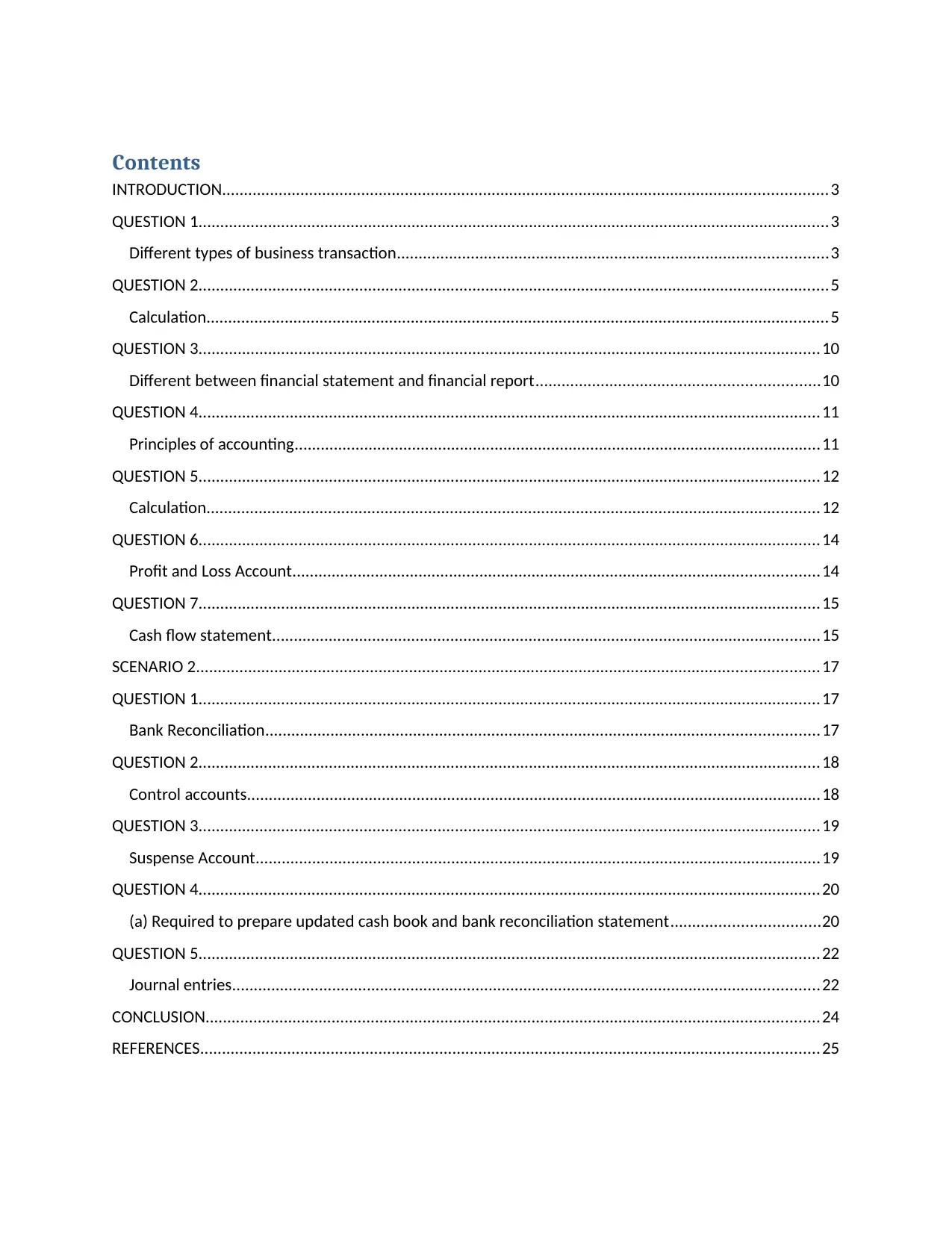
Contents
INTRODUCTION...........................................................................................................................................3
QUESTION 1.................................................................................................................................................3
Different types of business transaction...................................................................................................3
QUESTION 2.................................................................................................................................................5
Calculation...............................................................................................................................................5
QUESTION 3...............................................................................................................................................10
Different between financial statement and financial report.................................................................10
QUESTION 4...............................................................................................................................................11
Principles of accounting.........................................................................................................................11
QUESTION 5...............................................................................................................................................12
Calculation.............................................................................................................................................12
QUESTION 6...............................................................................................................................................14
Profit and Loss Account.........................................................................................................................14
QUESTION 7...............................................................................................................................................15
Cash flow statement..............................................................................................................................15
SCENARIO 2...............................................................................................................................................17
QUESTION 1...............................................................................................................................................17
Bank Reconciliation...............................................................................................................................17
QUESTION 2...............................................................................................................................................18
Control accounts....................................................................................................................................18
QUESTION 3...............................................................................................................................................19
Suspense Account..................................................................................................................................19
QUESTION 4...............................................................................................................................................20
(a) Required to prepare updated cash book and bank reconciliation statement..................................20
QUESTION 5...............................................................................................................................................22
Journal entries.......................................................................................................................................22
CONCLUSION.............................................................................................................................................24
REFERENCES..............................................................................................................................................25
INTRODUCTION...........................................................................................................................................3
QUESTION 1.................................................................................................................................................3
Different types of business transaction...................................................................................................3
QUESTION 2.................................................................................................................................................5
Calculation...............................................................................................................................................5
QUESTION 3...............................................................................................................................................10
Different between financial statement and financial report.................................................................10
QUESTION 4...............................................................................................................................................11
Principles of accounting.........................................................................................................................11
QUESTION 5...............................................................................................................................................12
Calculation.............................................................................................................................................12
QUESTION 6...............................................................................................................................................14
Profit and Loss Account.........................................................................................................................14
QUESTION 7...............................................................................................................................................15
Cash flow statement..............................................................................................................................15
SCENARIO 2...............................................................................................................................................17
QUESTION 1...............................................................................................................................................17
Bank Reconciliation...............................................................................................................................17
QUESTION 2...............................................................................................................................................18
Control accounts....................................................................................................................................18
QUESTION 3...............................................................................................................................................19
Suspense Account..................................................................................................................................19
QUESTION 4...............................................................................................................................................20
(a) Required to prepare updated cash book and bank reconciliation statement..................................20
QUESTION 5...............................................................................................................................................22
Journal entries.......................................................................................................................................22
CONCLUSION.............................................................................................................................................24
REFERENCES..............................................................................................................................................25
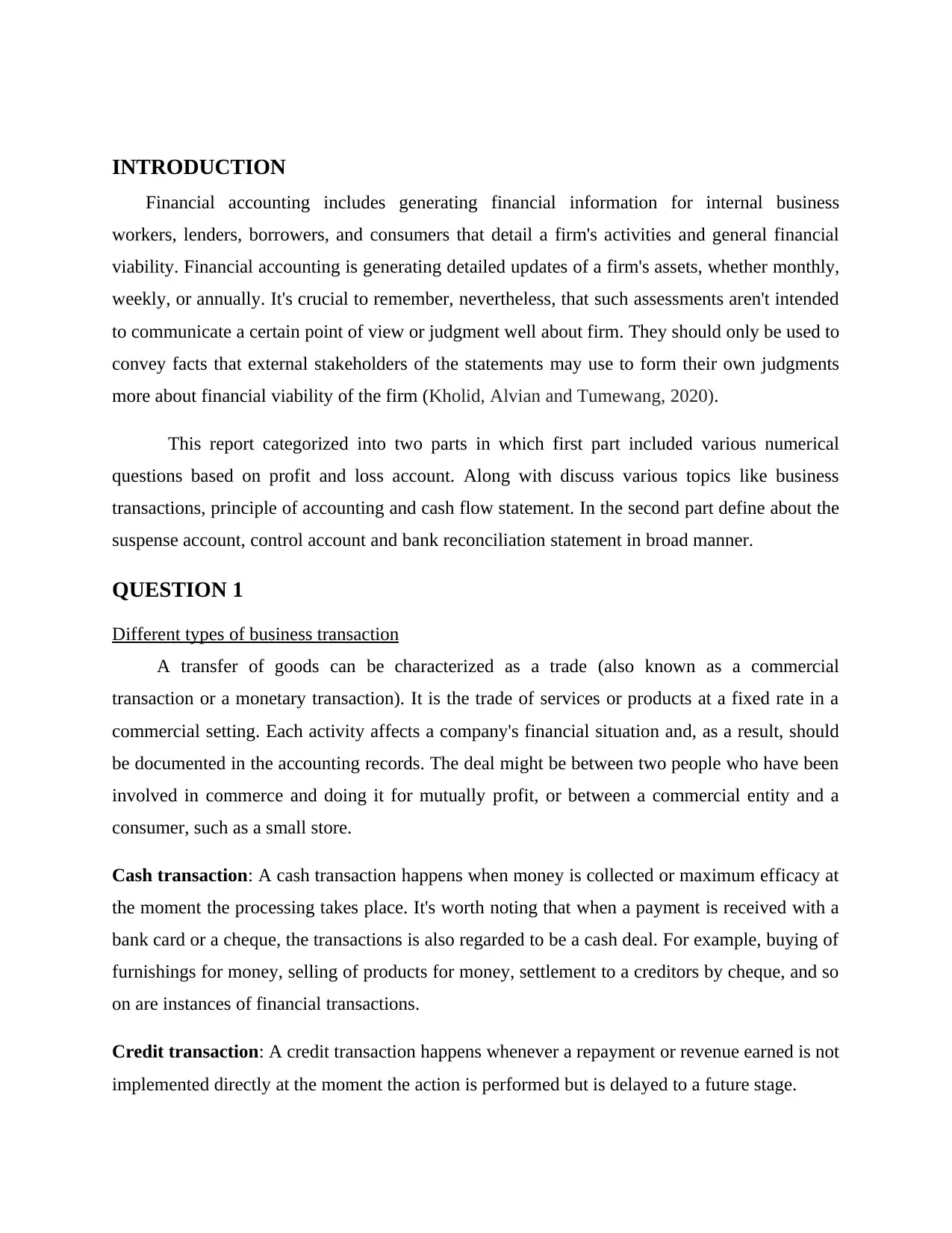
INTRODUCTION
Financial accounting includes generating financial information for internal business
workers, lenders, borrowers, and consumers that detail a firm's activities and general financial
viability. Financial accounting is generating detailed updates of a firm's assets, whether monthly,
weekly, or annually. It's crucial to remember, nevertheless, that such assessments aren't intended
to communicate a certain point of view or judgment well about firm. They should only be used to
convey facts that external stakeholders of the statements may use to form their own judgments
more about financial viability of the firm (Kholid, Alvian and Tumewang, 2020).
This report categorized into two parts in which first part included various numerical
questions based on profit and loss account. Along with discuss various topics like business
transactions, principle of accounting and cash flow statement. In the second part define about the
suspense account, control account and bank reconciliation statement in broad manner.
QUESTION 1
Different types of business transaction
A transfer of goods can be characterized as a trade (also known as a commercial
transaction or a monetary transaction). It is the trade of services or products at a fixed rate in a
commercial setting. Each activity affects a company's financial situation and, as a result, should
be documented in the accounting records. The deal might be between two people who have been
involved in commerce and doing it for mutually profit, or between a commercial entity and a
consumer, such as a small store.
Cash transaction: A cash transaction happens when money is collected or maximum efficacy at
the moment the processing takes place. It's worth noting that when a payment is received with a
bank card or a cheque, the transactions is also regarded to be a cash deal. For example, buying of
furnishings for money, selling of products for money, settlement to a creditors by cheque, and so
on are instances of financial transactions.
Credit transaction: A credit transaction happens whenever a repayment or revenue earned is not
implemented directly at the moment the action is performed but is delayed to a future stage.
Financial accounting includes generating financial information for internal business
workers, lenders, borrowers, and consumers that detail a firm's activities and general financial
viability. Financial accounting is generating detailed updates of a firm's assets, whether monthly,
weekly, or annually. It's crucial to remember, nevertheless, that such assessments aren't intended
to communicate a certain point of view or judgment well about firm. They should only be used to
convey facts that external stakeholders of the statements may use to form their own judgments
more about financial viability of the firm (Kholid, Alvian and Tumewang, 2020).
This report categorized into two parts in which first part included various numerical
questions based on profit and loss account. Along with discuss various topics like business
transactions, principle of accounting and cash flow statement. In the second part define about the
suspense account, control account and bank reconciliation statement in broad manner.
QUESTION 1
Different types of business transaction
A transfer of goods can be characterized as a trade (also known as a commercial
transaction or a monetary transaction). It is the trade of services or products at a fixed rate in a
commercial setting. Each activity affects a company's financial situation and, as a result, should
be documented in the accounting records. The deal might be between two people who have been
involved in commerce and doing it for mutually profit, or between a commercial entity and a
consumer, such as a small store.
Cash transaction: A cash transaction happens when money is collected or maximum efficacy at
the moment the processing takes place. It's worth noting that when a payment is received with a
bank card or a cheque, the transactions is also regarded to be a cash deal. For example, buying of
furnishings for money, selling of products for money, settlement to a creditors by cheque, and so
on are instances of financial transactions.
Credit transaction: A credit transaction happens whenever a repayment or revenue earned is not
implemented directly at the moment the action is performed but is delayed to a future stage.
Secure Best Marks with AI Grader
Need help grading? Try our AI Grader for instant feedback on your assignments.
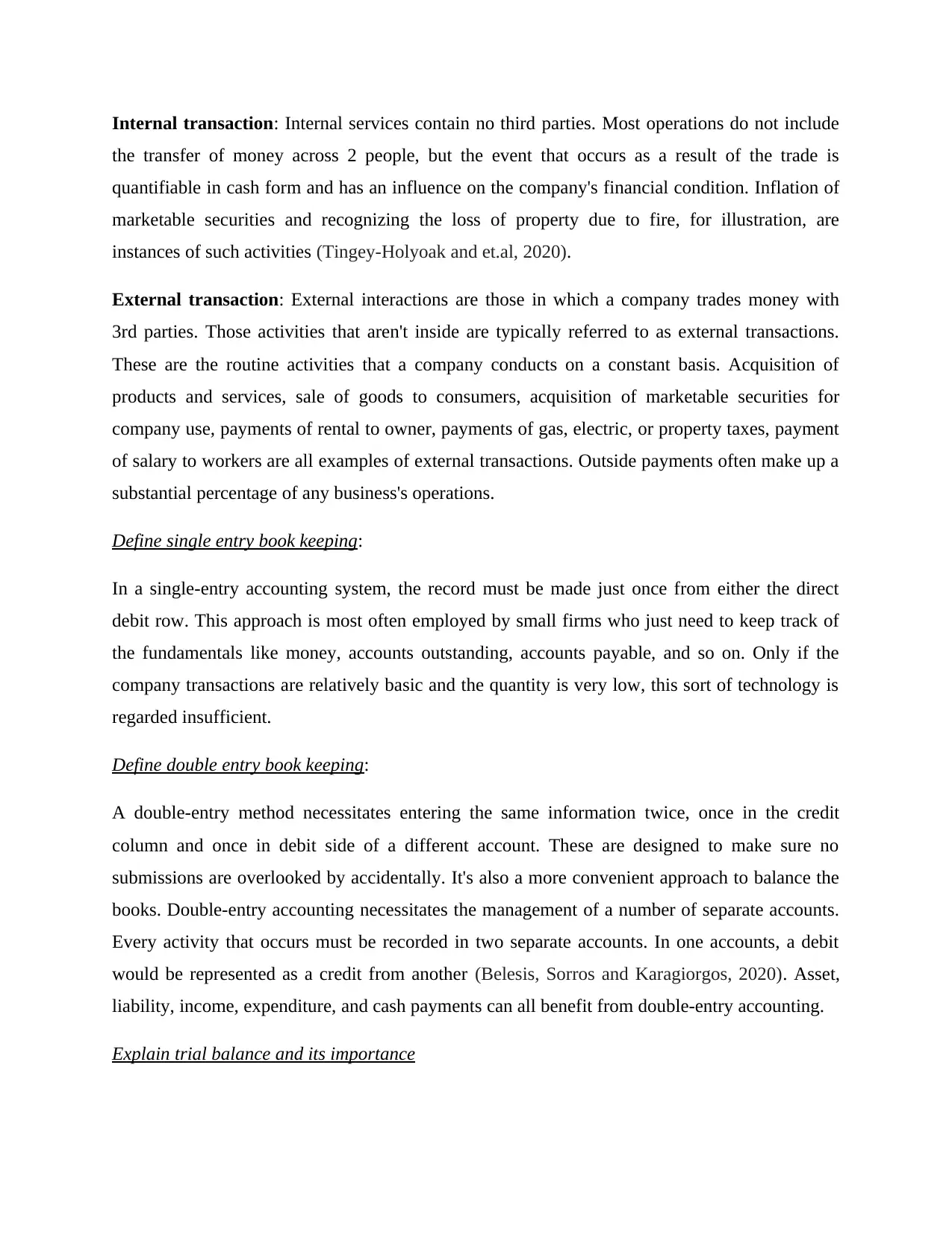
Internal transaction: Internal services contain no third parties. Most operations do not include
the transfer of money across 2 people, but the event that occurs as a result of the trade is
quantifiable in cash form and has an influence on the company's financial condition. Inflation of
marketable securities and recognizing the loss of property due to fire, for illustration, are
instances of such activities (Tingey-Holyoak and et.al, 2020).
External transaction: External interactions are those in which a company trades money with
3rd parties. Those activities that aren't inside are typically referred to as external transactions.
These are the routine activities that a company conducts on a constant basis. Acquisition of
products and services, sale of goods to consumers, acquisition of marketable securities for
company use, payments of rental to owner, payments of gas, electric, or property taxes, payment
of salary to workers are all examples of external transactions. Outside payments often make up a
substantial percentage of any business's operations.
Define single entry book keeping:
In a single-entry accounting system, the record must be made just once from either the direct
debit row. This approach is most often employed by small firms who just need to keep track of
the fundamentals like money, accounts outstanding, accounts payable, and so on. Only if the
company transactions are relatively basic and the quantity is very low, this sort of technology is
regarded insufficient.
Define double entry book keeping:
A double-entry method necessitates entering the same information twice, once in the credit
column and once in debit side of a different account. These are designed to make sure no
submissions are overlooked by accidentally. It's also a more convenient approach to balance the
books. Double-entry accounting necessitates the management of a number of separate accounts.
Every activity that occurs must be recorded in two separate accounts. In one accounts, a debit
would be represented as a credit from another (Belesis, Sorros and Karagiorgos, 2020). Asset,
liability, income, expenditure, and cash payments can all benefit from double-entry accounting.
Explain trial balance and its importance
the transfer of money across 2 people, but the event that occurs as a result of the trade is
quantifiable in cash form and has an influence on the company's financial condition. Inflation of
marketable securities and recognizing the loss of property due to fire, for illustration, are
instances of such activities (Tingey-Holyoak and et.al, 2020).
External transaction: External interactions are those in which a company trades money with
3rd parties. Those activities that aren't inside are typically referred to as external transactions.
These are the routine activities that a company conducts on a constant basis. Acquisition of
products and services, sale of goods to consumers, acquisition of marketable securities for
company use, payments of rental to owner, payments of gas, electric, or property taxes, payment
of salary to workers are all examples of external transactions. Outside payments often make up a
substantial percentage of any business's operations.
Define single entry book keeping:
In a single-entry accounting system, the record must be made just once from either the direct
debit row. This approach is most often employed by small firms who just need to keep track of
the fundamentals like money, accounts outstanding, accounts payable, and so on. Only if the
company transactions are relatively basic and the quantity is very low, this sort of technology is
regarded insufficient.
Define double entry book keeping:
A double-entry method necessitates entering the same information twice, once in the credit
column and once in debit side of a different account. These are designed to make sure no
submissions are overlooked by accidentally. It's also a more convenient approach to balance the
books. Double-entry accounting necessitates the management of a number of separate accounts.
Every activity that occurs must be recorded in two separate accounts. In one accounts, a debit
would be represented as a credit from another (Belesis, Sorros and Karagiorgos, 2020). Asset,
liability, income, expenditure, and cash payments can all benefit from double-entry accounting.
Explain trial balance and its importance
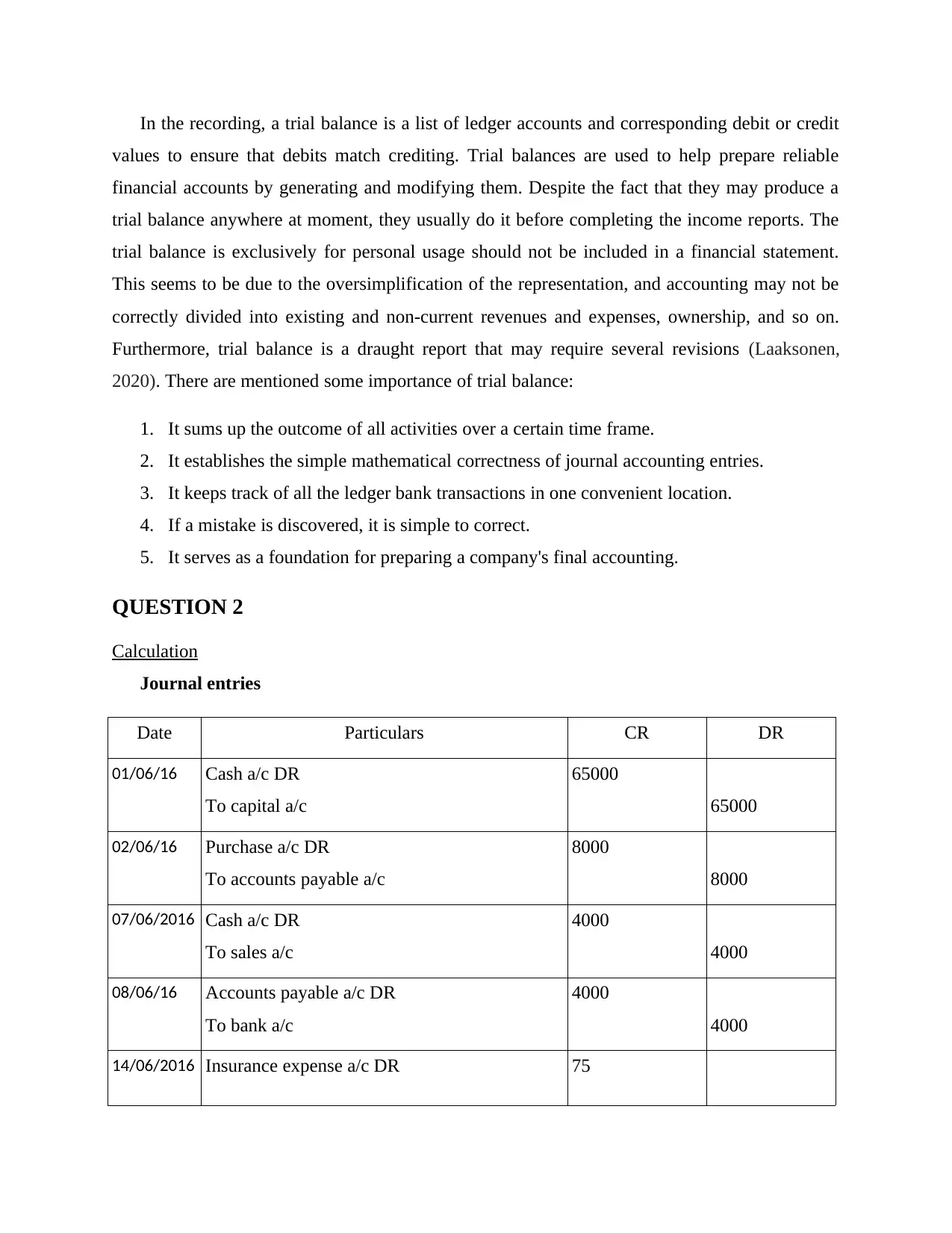
In the recording, a trial balance is a list of ledger accounts and corresponding debit or credit
values to ensure that debits match crediting. Trial balances are used to help prepare reliable
financial accounts by generating and modifying them. Despite the fact that they may produce a
trial balance anywhere at moment, they usually do it before completing the income reports. The
trial balance is exclusively for personal usage should not be included in a financial statement.
This seems to be due to the oversimplification of the representation, and accounting may not be
correctly divided into existing and non-current revenues and expenses, ownership, and so on.
Furthermore, trial balance is a draught report that may require several revisions (Laaksonen,
2020). There are mentioned some importance of trial balance:
1. It sums up the outcome of all activities over a certain time frame.
2. It establishes the simple mathematical correctness of journal accounting entries.
3. It keeps track of all the ledger bank transactions in one convenient location.
4. If a mistake is discovered, it is simple to correct.
5. It serves as a foundation for preparing a company's final accounting.
QUESTION 2
Calculation
Journal entries
Date Particulars CR DR
01/06/16 Cash a/c DR
To capital a/c
65000
65000
02/06/16 Purchase a/c DR
To accounts payable a/c
8000
8000
07/06/2016 Cash a/c DR
To sales a/c
4000
4000
08/06/16 Accounts payable a/c DR
To bank a/c
4000
4000
14/06/2016 Insurance expense a/c DR 75
values to ensure that debits match crediting. Trial balances are used to help prepare reliable
financial accounts by generating and modifying them. Despite the fact that they may produce a
trial balance anywhere at moment, they usually do it before completing the income reports. The
trial balance is exclusively for personal usage should not be included in a financial statement.
This seems to be due to the oversimplification of the representation, and accounting may not be
correctly divided into existing and non-current revenues and expenses, ownership, and so on.
Furthermore, trial balance is a draught report that may require several revisions (Laaksonen,
2020). There are mentioned some importance of trial balance:
1. It sums up the outcome of all activities over a certain time frame.
2. It establishes the simple mathematical correctness of journal accounting entries.
3. It keeps track of all the ledger bank transactions in one convenient location.
4. If a mistake is discovered, it is simple to correct.
5. It serves as a foundation for preparing a company's final accounting.
QUESTION 2
Calculation
Journal entries
Date Particulars CR DR
01/06/16 Cash a/c DR
To capital a/c
65000
65000
02/06/16 Purchase a/c DR
To accounts payable a/c
8000
8000
07/06/2016 Cash a/c DR
To sales a/c
4000
4000
08/06/16 Accounts payable a/c DR
To bank a/c
4000
4000
14/06/2016 Insurance expense a/c DR 75
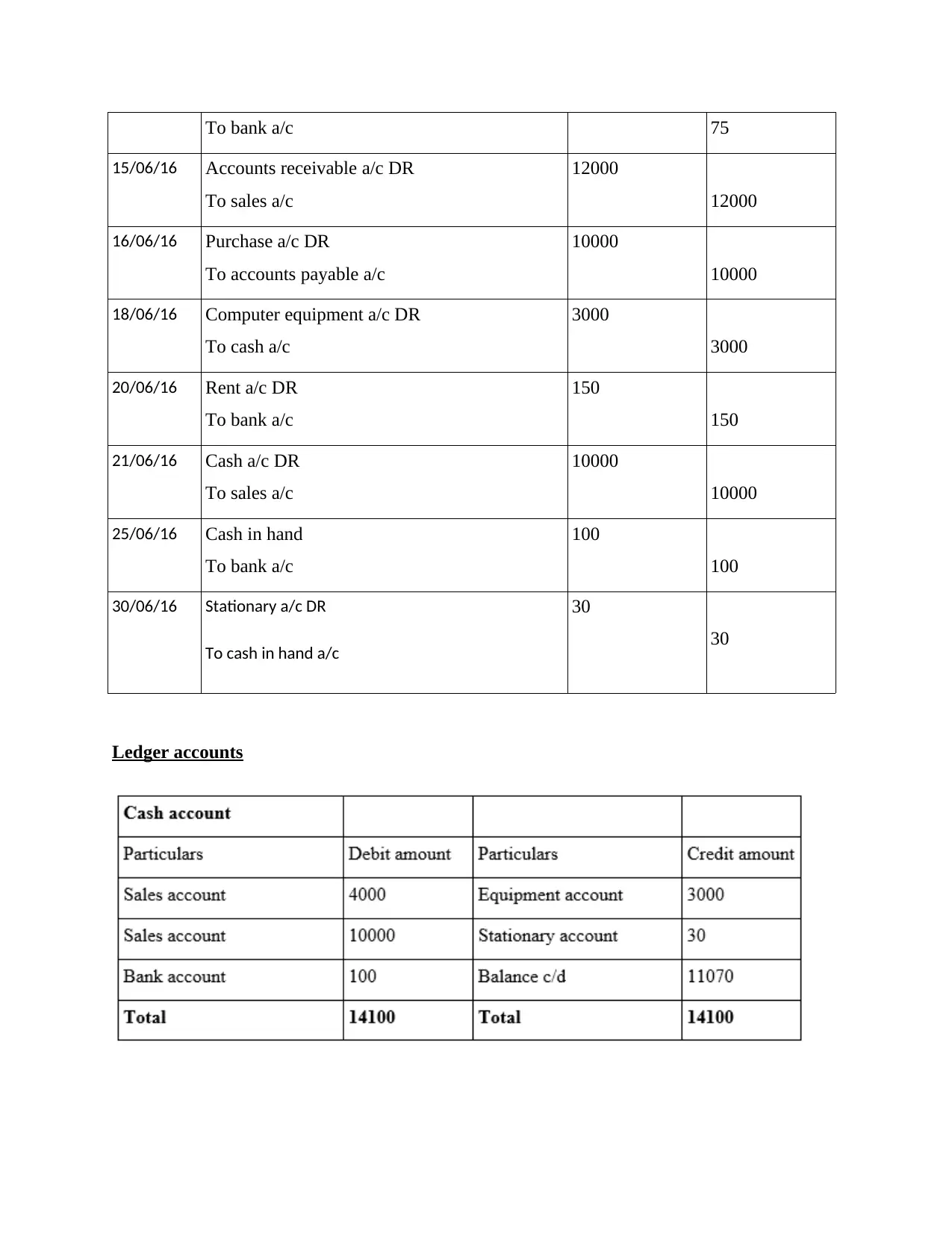
To bank a/c 75
15/06/16 Accounts receivable a/c DR
To sales a/c
12000
12000
16/06/16 Purchase a/c DR
To accounts payable a/c
10000
10000
18/06/16 Computer equipment a/c DR
To cash a/c
3000
3000
20/06/16 Rent a/c DR
To bank a/c
150
150
21/06/16 Cash a/c DR
To sales a/c
10000
10000
25/06/16 Cash in hand
To bank a/c
100
100
30/06/16 Stationary a/c DR
To cash in hand a/c
30
30
Ledger accounts
15/06/16 Accounts receivable a/c DR
To sales a/c
12000
12000
16/06/16 Purchase a/c DR
To accounts payable a/c
10000
10000
18/06/16 Computer equipment a/c DR
To cash a/c
3000
3000
20/06/16 Rent a/c DR
To bank a/c
150
150
21/06/16 Cash a/c DR
To sales a/c
10000
10000
25/06/16 Cash in hand
To bank a/c
100
100
30/06/16 Stationary a/c DR
To cash in hand a/c
30
30
Ledger accounts
Paraphrase This Document
Need a fresh take? Get an instant paraphrase of this document with our AI Paraphraser
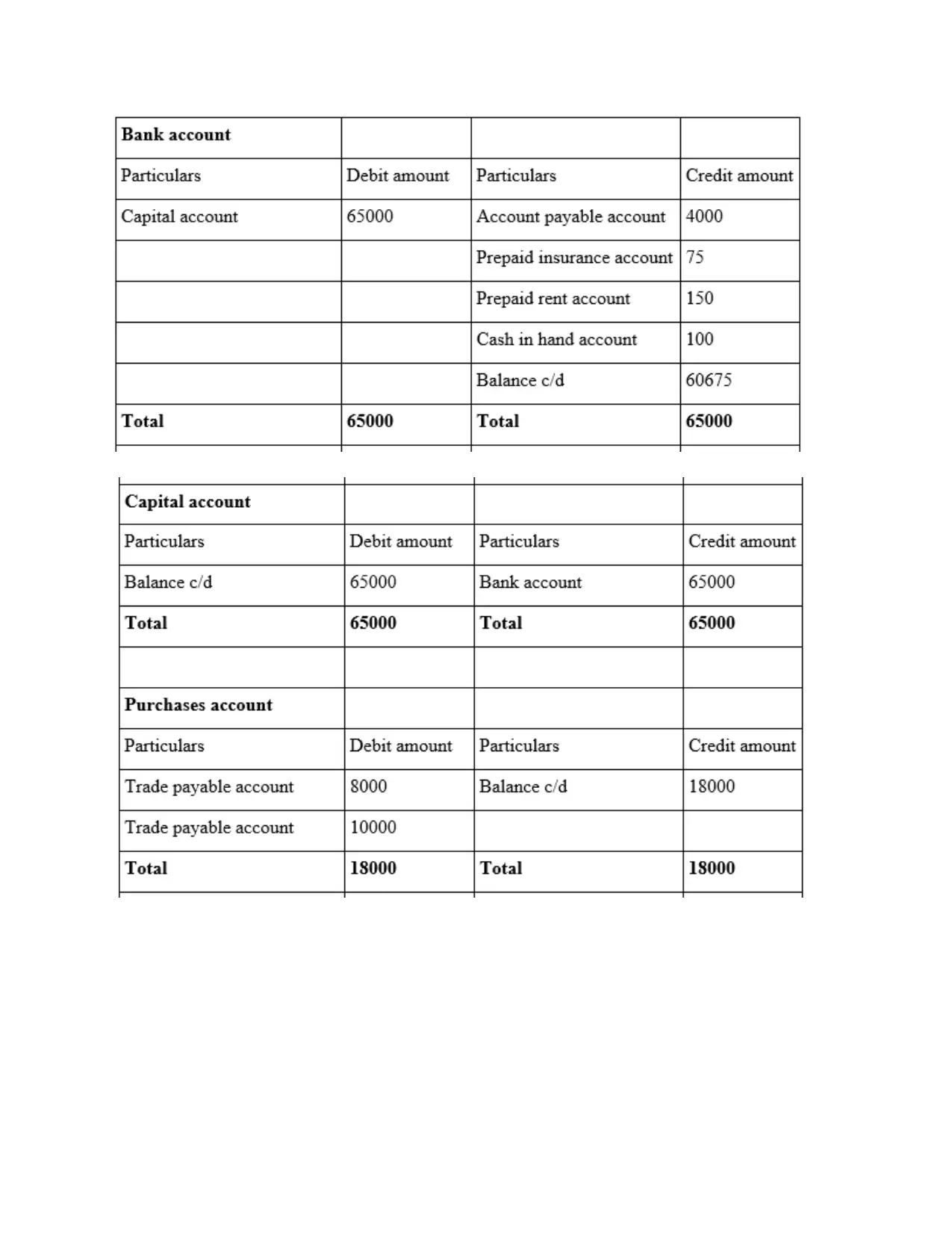
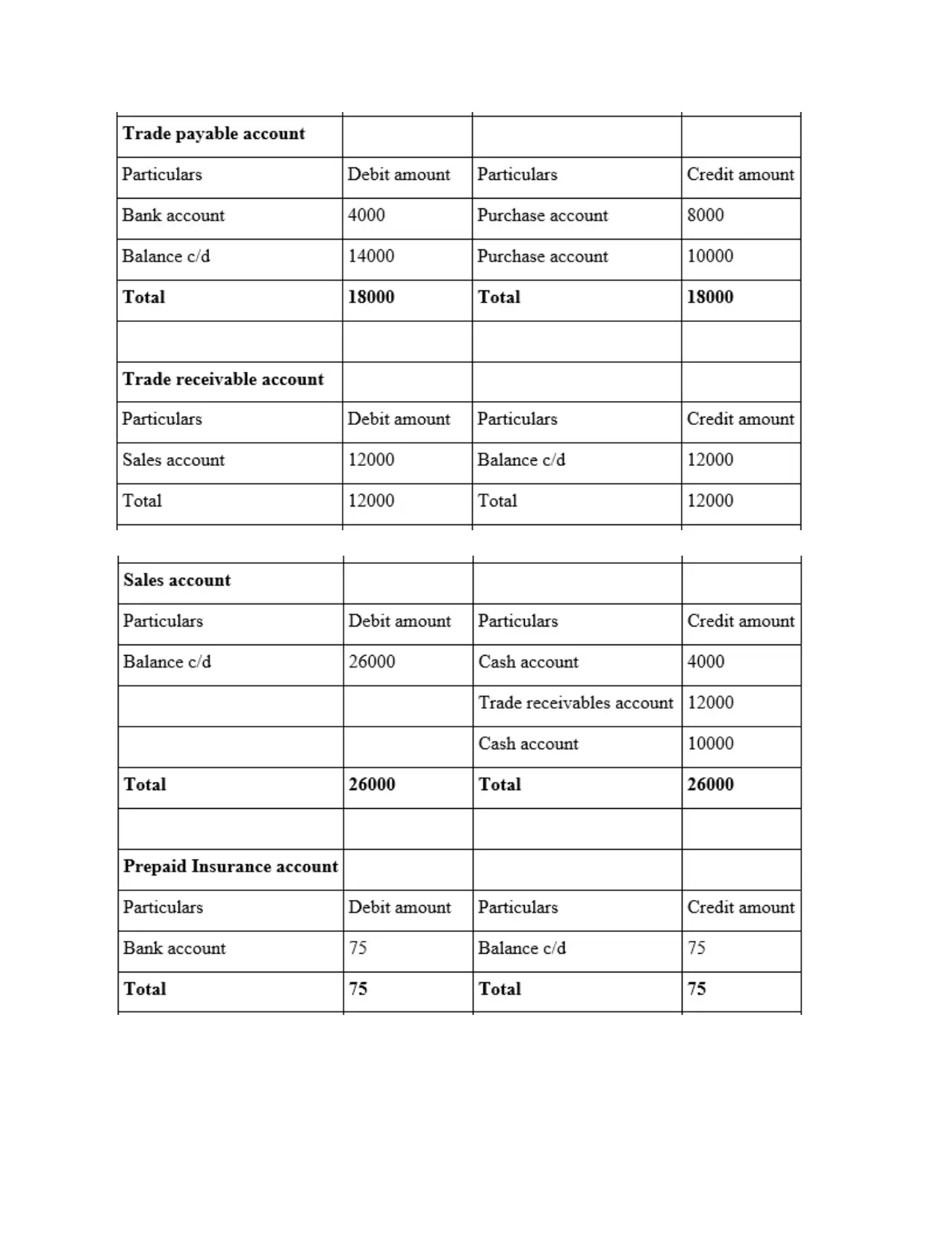
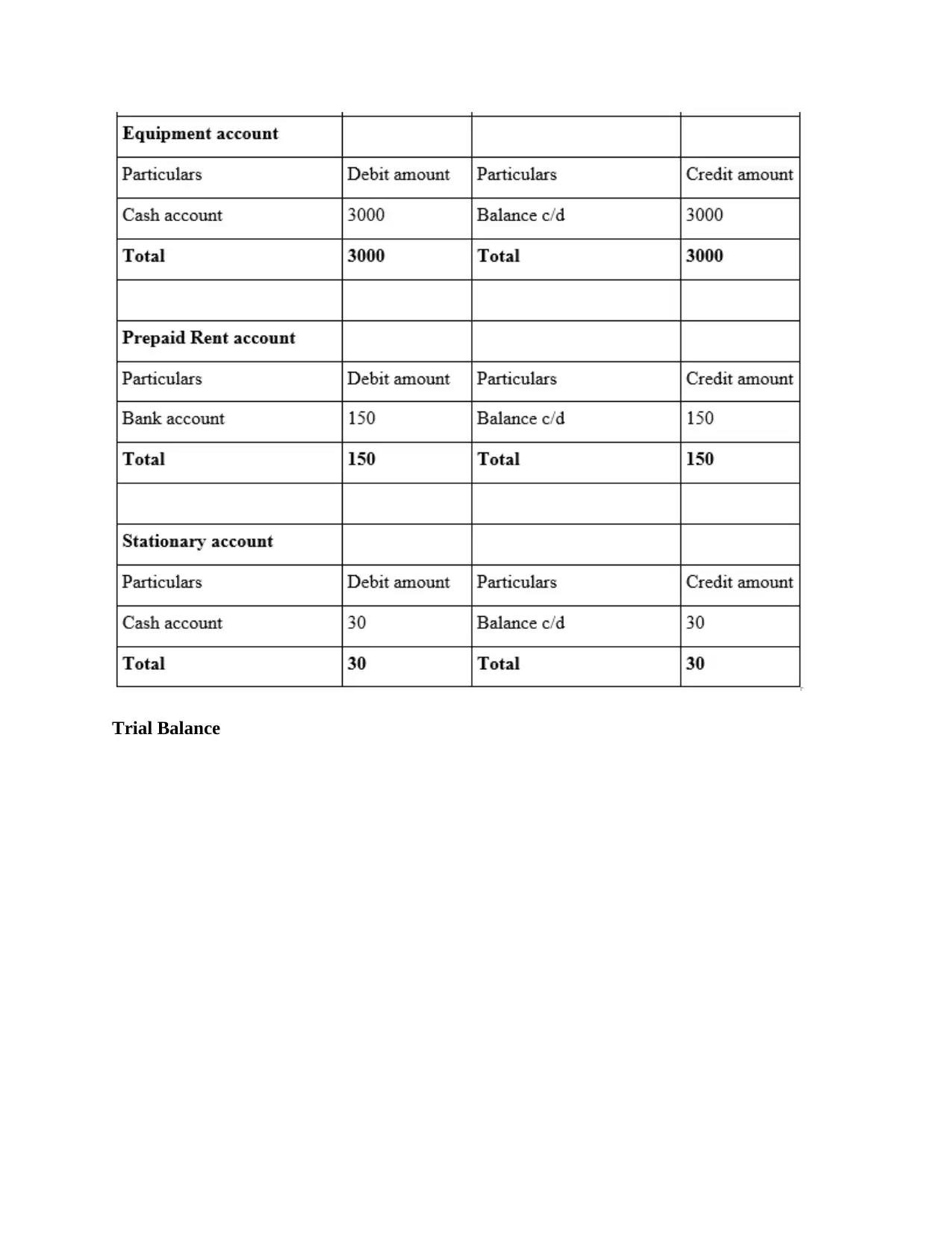
Trial Balance
Secure Best Marks with AI Grader
Need help grading? Try our AI Grader for instant feedback on your assignments.
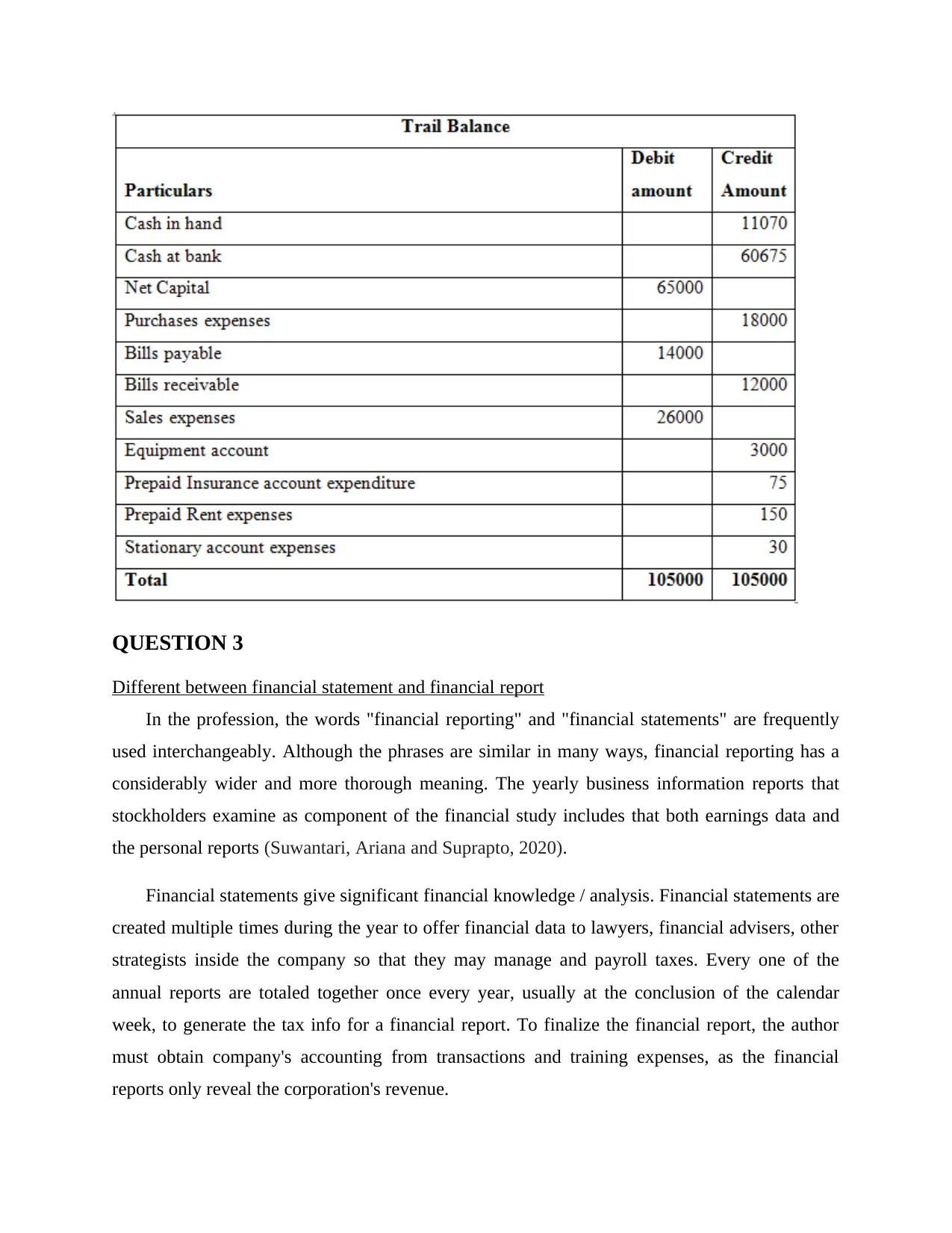
QUESTION 3
Different between financial statement and financial report
In the profession, the words "financial reporting" and "financial statements" are frequently
used interchangeably. Although the phrases are similar in many ways, financial reporting has a
considerably wider and more thorough meaning. The yearly business information reports that
stockholders examine as component of the financial study includes that both earnings data and
the personal reports (Suwantari, Ariana and Suprapto, 2020).
Financial statements give significant financial knowledge / analysis. Financial statements are
created multiple times during the year to offer financial data to lawyers, financial advisers, other
strategists inside the company so that they may manage and payroll taxes. Every one of the
annual reports are totaled together once every year, usually at the conclusion of the calendar
week, to generate the tax info for a financial report. To finalize the financial report, the author
must obtain company's accounting from transactions and training expenses, as the financial
reports only reveal the corporation's revenue.
Different between financial statement and financial report
In the profession, the words "financial reporting" and "financial statements" are frequently
used interchangeably. Although the phrases are similar in many ways, financial reporting has a
considerably wider and more thorough meaning. The yearly business information reports that
stockholders examine as component of the financial study includes that both earnings data and
the personal reports (Suwantari, Ariana and Suprapto, 2020).
Financial statements give significant financial knowledge / analysis. Financial statements are
created multiple times during the year to offer financial data to lawyers, financial advisers, other
strategists inside the company so that they may manage and payroll taxes. Every one of the
annual reports are totaled together once every year, usually at the conclusion of the calendar
week, to generate the tax info for a financial report. To finalize the financial report, the author
must obtain company's accounting from transactions and training expenses, as the financial
reports only reveal the corporation's revenue.
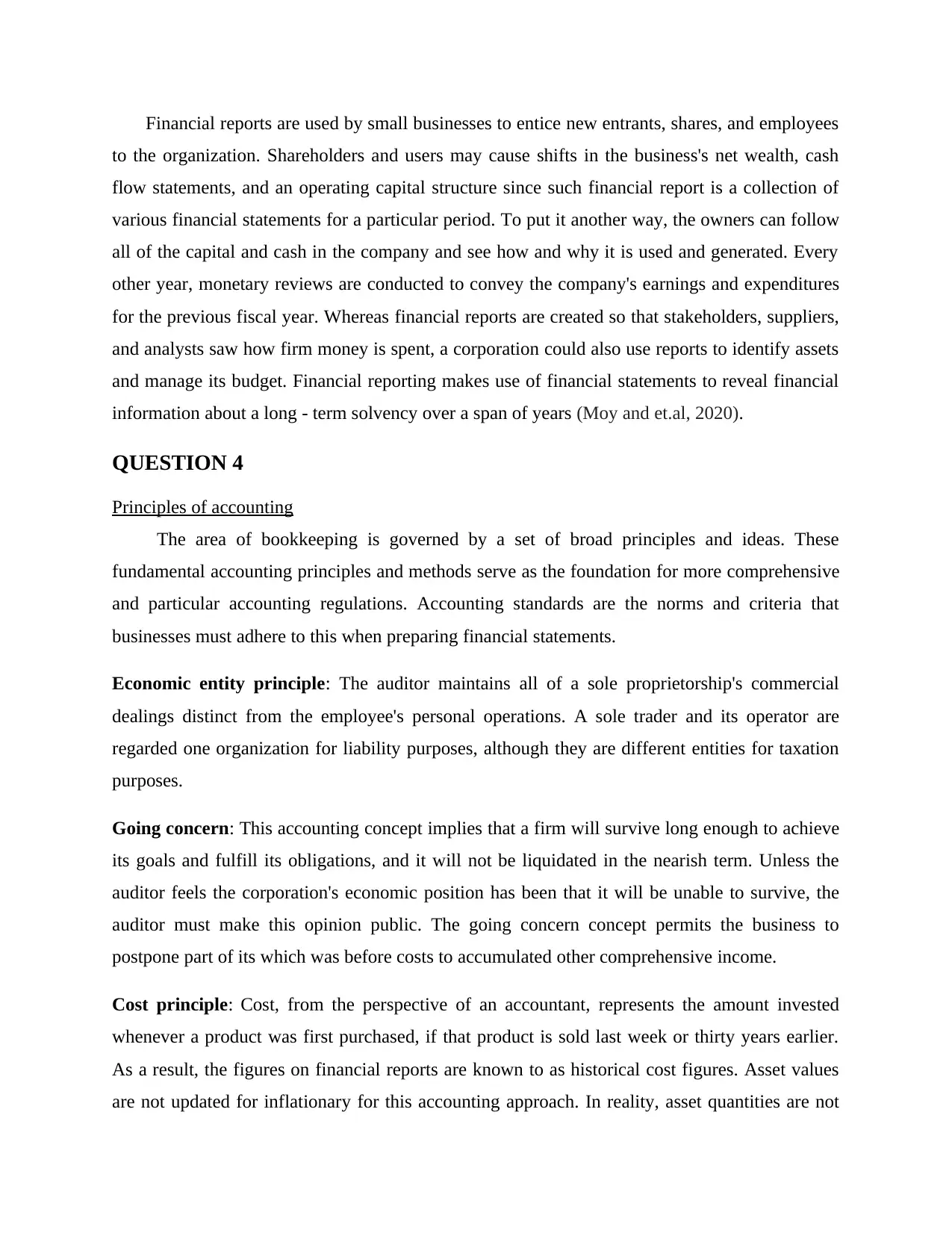
Financial reports are used by small businesses to entice new entrants, shares, and employees
to the organization. Shareholders and users may cause shifts in the business's net wealth, cash
flow statements, and an operating capital structure since such financial report is a collection of
various financial statements for a particular period. To put it another way, the owners can follow
all of the capital and cash in the company and see how and why it is used and generated. Every
other year, monetary reviews are conducted to convey the company's earnings and expenditures
for the previous fiscal year. Whereas financial reports are created so that stakeholders, suppliers,
and analysts saw how firm money is spent, a corporation could also use reports to identify assets
and manage its budget. Financial reporting makes use of financial statements to reveal financial
information about a long - term solvency over a span of years (Moy and et.al, 2020).
QUESTION 4
Principles of accounting
The area of bookkeeping is governed by a set of broad principles and ideas. These
fundamental accounting principles and methods serve as the foundation for more comprehensive
and particular accounting regulations. Accounting standards are the norms and criteria that
businesses must adhere to this when preparing financial statements.
Economic entity principle: The auditor maintains all of a sole proprietorship's commercial
dealings distinct from the employee's personal operations. A sole trader and its operator are
regarded one organization for liability purposes, although they are different entities for taxation
purposes.
Going concern: This accounting concept implies that a firm will survive long enough to achieve
its goals and fulfill its obligations, and it will not be liquidated in the nearish term. Unless the
auditor feels the corporation's economic position has been that it will be unable to survive, the
auditor must make this opinion public. The going concern concept permits the business to
postpone part of its which was before costs to accumulated other comprehensive income.
Cost principle: Cost, from the perspective of an accountant, represents the amount invested
whenever a product was first purchased, if that product is sold last week or thirty years earlier.
As a result, the figures on financial reports are known to as historical cost figures. Asset values
are not updated for inflationary for this accounting approach. In reality, asset quantities are not
to the organization. Shareholders and users may cause shifts in the business's net wealth, cash
flow statements, and an operating capital structure since such financial report is a collection of
various financial statements for a particular period. To put it another way, the owners can follow
all of the capital and cash in the company and see how and why it is used and generated. Every
other year, monetary reviews are conducted to convey the company's earnings and expenditures
for the previous fiscal year. Whereas financial reports are created so that stakeholders, suppliers,
and analysts saw how firm money is spent, a corporation could also use reports to identify assets
and manage its budget. Financial reporting makes use of financial statements to reveal financial
information about a long - term solvency over a span of years (Moy and et.al, 2020).
QUESTION 4
Principles of accounting
The area of bookkeeping is governed by a set of broad principles and ideas. These
fundamental accounting principles and methods serve as the foundation for more comprehensive
and particular accounting regulations. Accounting standards are the norms and criteria that
businesses must adhere to this when preparing financial statements.
Economic entity principle: The auditor maintains all of a sole proprietorship's commercial
dealings distinct from the employee's personal operations. A sole trader and its operator are
regarded one organization for liability purposes, although they are different entities for taxation
purposes.
Going concern: This accounting concept implies that a firm will survive long enough to achieve
its goals and fulfill its obligations, and it will not be liquidated in the nearish term. Unless the
auditor feels the corporation's economic position has been that it will be unable to survive, the
auditor must make this opinion public. The going concern concept permits the business to
postpone part of its which was before costs to accumulated other comprehensive income.
Cost principle: Cost, from the perspective of an accountant, represents the amount invested
whenever a product was first purchased, if that product is sold last week or thirty years earlier.
As a result, the figures on financial reports are known to as historical cost figures. Asset values
are not updated for inflationary for this accounting approach. In reality, asset quantities are not
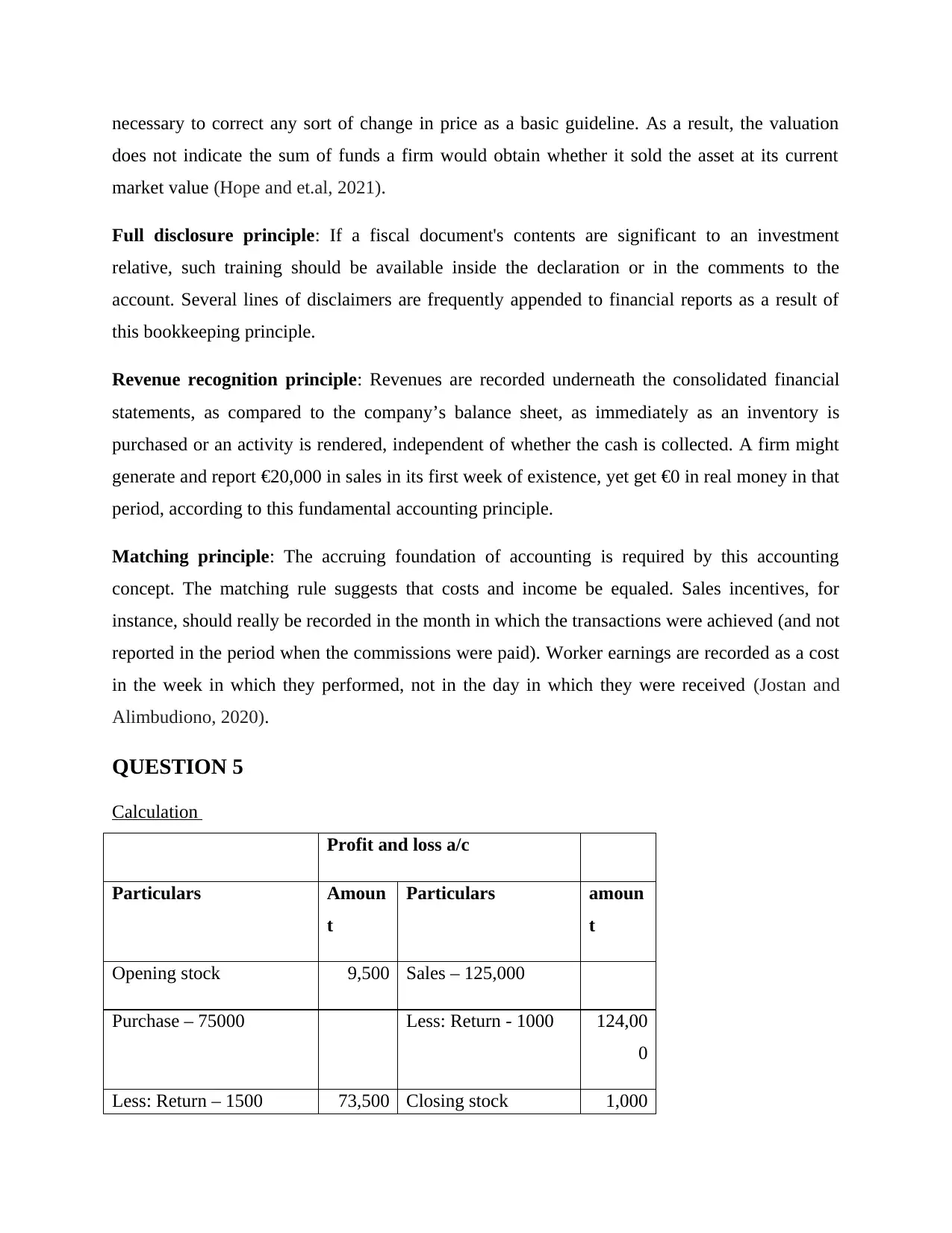
necessary to correct any sort of change in price as a basic guideline. As a result, the valuation
does not indicate the sum of funds a firm would obtain whether it sold the asset at its current
market value (Hope and et.al, 2021).
Full disclosure principle: If a fiscal document's contents are significant to an investment
relative, such training should be available inside the declaration or in the comments to the
account. Several lines of disclaimers are frequently appended to financial reports as a result of
this bookkeeping principle.
Revenue recognition principle: Revenues are recorded underneath the consolidated financial
statements, as compared to the company’s balance sheet, as immediately as an inventory is
purchased or an activity is rendered, independent of whether the cash is collected. A firm might
generate and report €20,000 in sales in its first week of existence, yet get €0 in real money in that
period, according to this fundamental accounting principle.
Matching principle: The accruing foundation of accounting is required by this accounting
concept. The matching rule suggests that costs and income be equaled. Sales incentives, for
instance, should really be recorded in the month in which the transactions were achieved (and not
reported in the period when the commissions were paid). Worker earnings are recorded as a cost
in the week in which they performed, not in the day in which they were received (Jostan and
Alimbudiono, 2020).
QUESTION 5
Calculation
Profit and loss a/c
Particulars Amoun
t
Particulars amoun
t
Opening stock 9,500 Sales – 125,000
Purchase – 75000 Less: Return - 1000 124,00
0
Less: Return – 1500 73,500 Closing stock 1,000
does not indicate the sum of funds a firm would obtain whether it sold the asset at its current
market value (Hope and et.al, 2021).
Full disclosure principle: If a fiscal document's contents are significant to an investment
relative, such training should be available inside the declaration or in the comments to the
account. Several lines of disclaimers are frequently appended to financial reports as a result of
this bookkeeping principle.
Revenue recognition principle: Revenues are recorded underneath the consolidated financial
statements, as compared to the company’s balance sheet, as immediately as an inventory is
purchased or an activity is rendered, independent of whether the cash is collected. A firm might
generate and report €20,000 in sales in its first week of existence, yet get €0 in real money in that
period, according to this fundamental accounting principle.
Matching principle: The accruing foundation of accounting is required by this accounting
concept. The matching rule suggests that costs and income be equaled. Sales incentives, for
instance, should really be recorded in the month in which the transactions were achieved (and not
reported in the period when the commissions were paid). Worker earnings are recorded as a cost
in the week in which they performed, not in the day in which they were received (Jostan and
Alimbudiono, 2020).
QUESTION 5
Calculation
Profit and loss a/c
Particulars Amoun
t
Particulars amoun
t
Opening stock 9,500 Sales – 125,000
Purchase – 75000 Less: Return - 1000 124,00
0
Less: Return – 1500 73,500 Closing stock 1,000
Paraphrase This Document
Need a fresh take? Get an instant paraphrase of this document with our AI Paraphraser
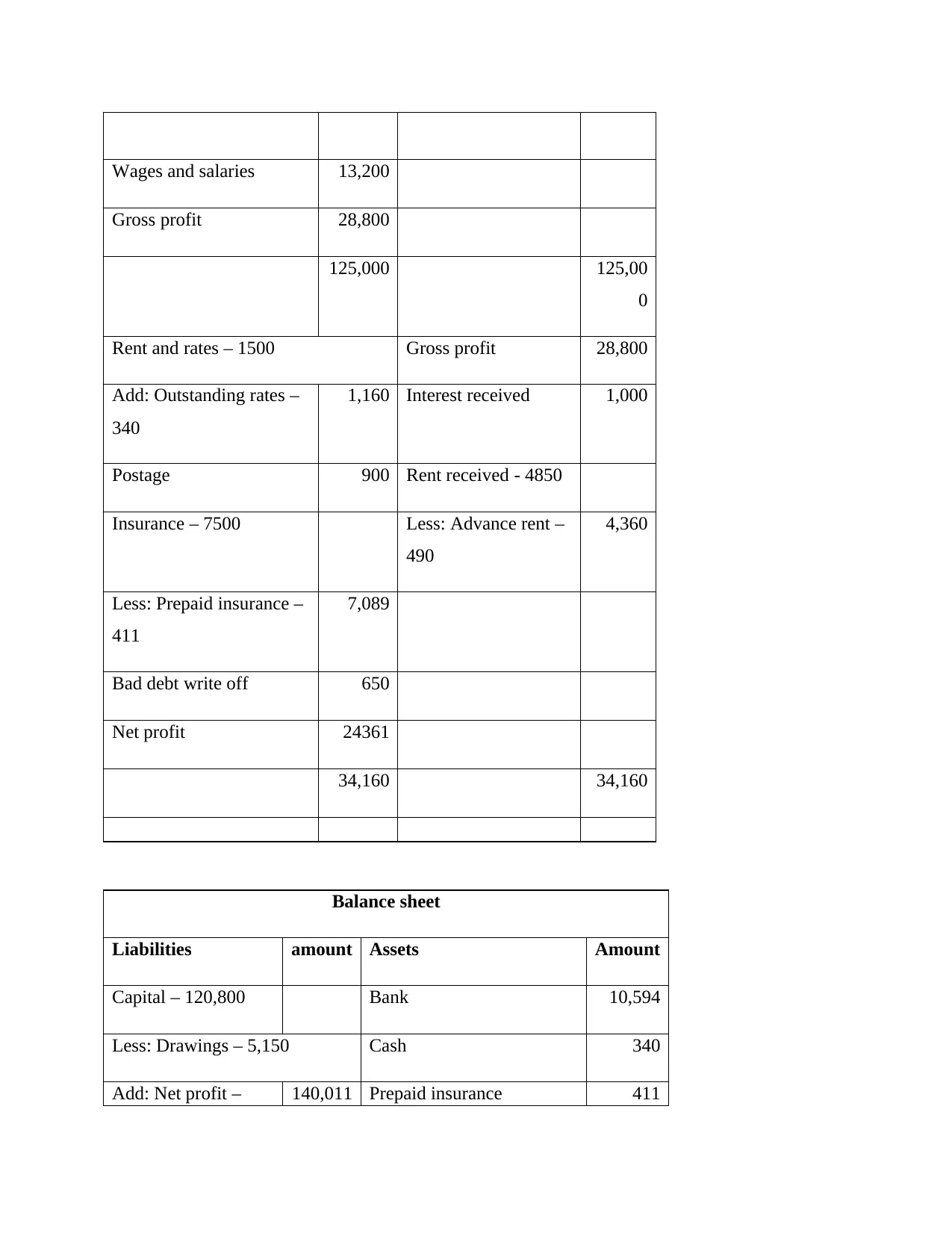
Wages and salaries 13,200
Gross profit 28,800
125,000 125,00
0
Rent and rates – 1500 Gross profit 28,800
Add: Outstanding rates –
340
1,160 Interest received 1,000
Postage 900 Rent received - 4850
Insurance – 7500 Less: Advance rent –
490
4,360
Less: Prepaid insurance –
411
7,089
Bad debt write off 650
Net profit 24361
34,160 34,160
Balance sheet
Liabilities amount Assets Amount
Capital – 120,800 Bank 10,594
Less: Drawings – 5,150 Cash 340
Add: Net profit – 140,011 Prepaid insurance 411
Gross profit 28,800
125,000 125,00
0
Rent and rates – 1500 Gross profit 28,800
Add: Outstanding rates –
340
1,160 Interest received 1,000
Postage 900 Rent received - 4850
Insurance – 7500 Less: Advance rent –
490
4,360
Less: Prepaid insurance –
411
7,089
Bad debt write off 650
Net profit 24361
34,160 34,160
Balance sheet
Liabilities amount Assets Amount
Capital – 120,800 Bank 10,594
Less: Drawings – 5,150 Cash 340
Add: Net profit – 140,011 Prepaid insurance 411
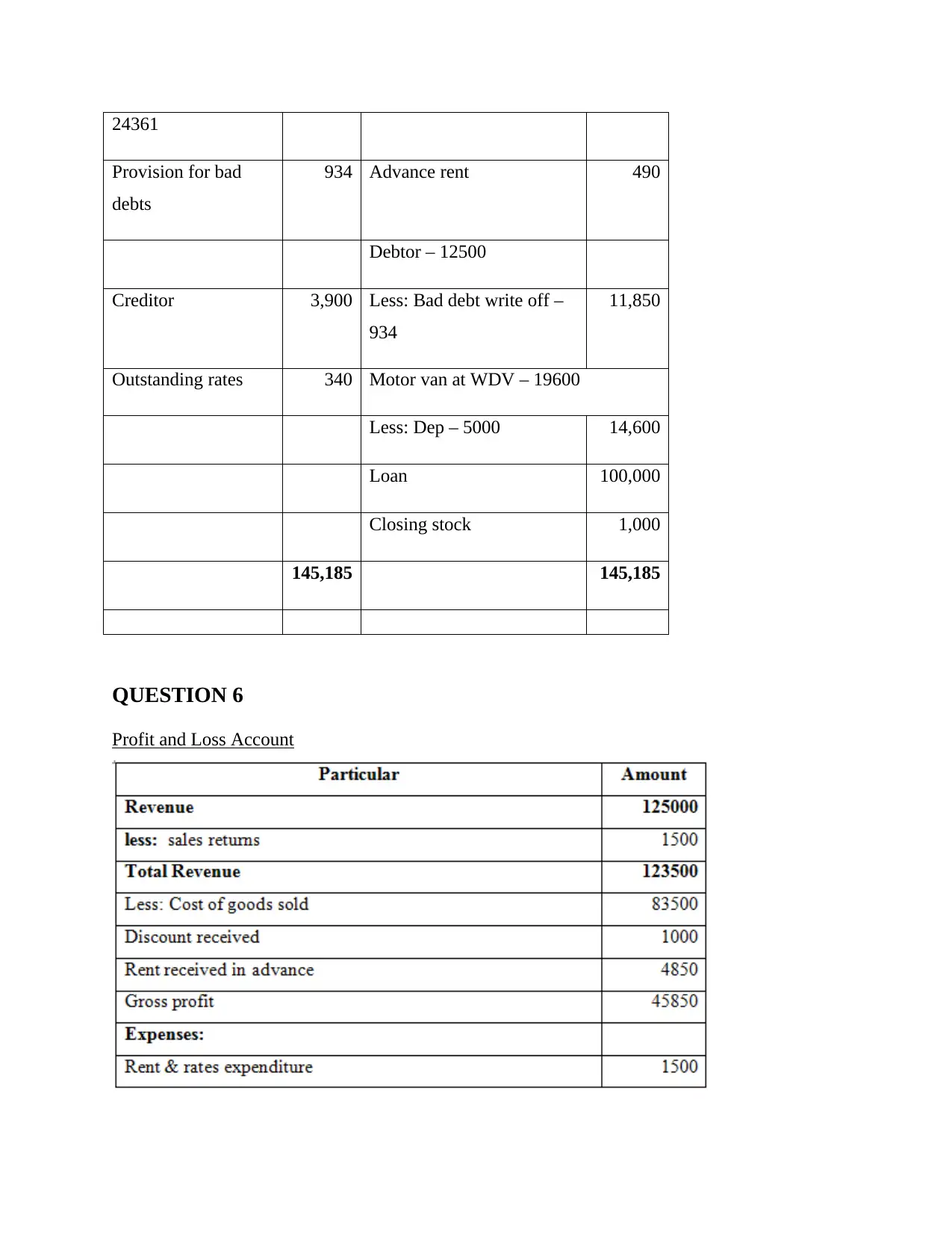
24361
Provision for bad
debts
934 Advance rent 490
Debtor – 12500
Creditor 3,900 Less: Bad debt write off –
934
11,850
Outstanding rates 340 Motor van at WDV – 19600
Less: Dep – 5000 14,600
Loan 100,000
Closing stock 1,000
145,185 145,185
QUESTION 6
Profit and Loss Account
Provision for bad
debts
934 Advance rent 490
Debtor – 12500
Creditor 3,900 Less: Bad debt write off –
934
11,850
Outstanding rates 340 Motor van at WDV – 19600
Less: Dep – 5000 14,600
Loan 100,000
Closing stock 1,000
145,185 145,185
QUESTION 6
Profit and Loss Account
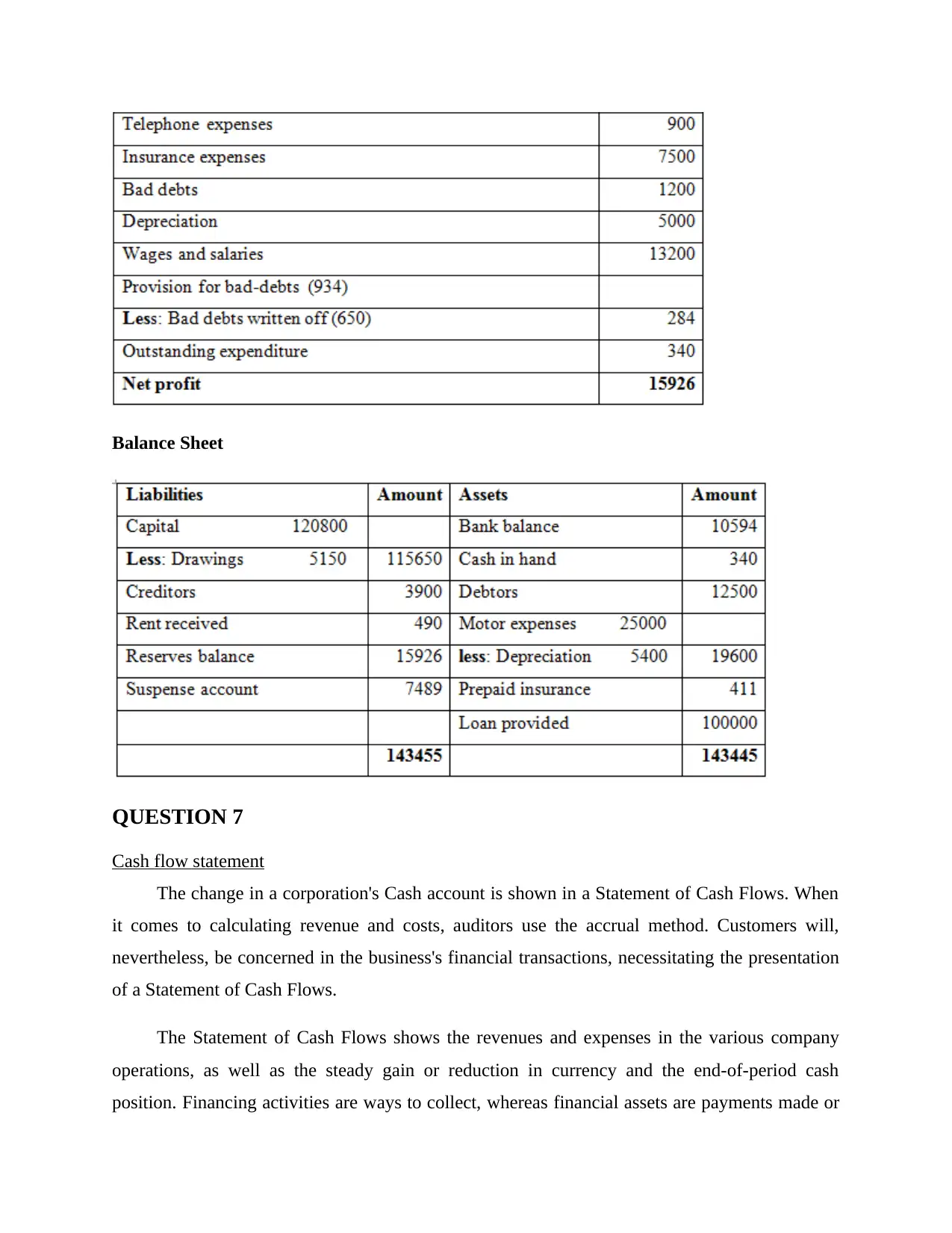
Balance Sheet
QUESTION 7
Cash flow statement
The change in a corporation's Cash account is shown in a Statement of Cash Flows. When
it comes to calculating revenue and costs, auditors use the accrual method. Customers will,
nevertheless, be concerned in the business's financial transactions, necessitating the presentation
of a Statement of Cash Flows.
The Statement of Cash Flows shows the revenues and expenses in the various company
operations, as well as the steady gain or reduction in currency and the end-of-period cash
position. Financing activities are ways to collect, whereas financial assets are payments made or
QUESTION 7
Cash flow statement
The change in a corporation's Cash account is shown in a Statement of Cash Flows. When
it comes to calculating revenue and costs, auditors use the accrual method. Customers will,
nevertheless, be concerned in the business's financial transactions, necessitating the presentation
of a Statement of Cash Flows.
The Statement of Cash Flows shows the revenues and expenses in the various company
operations, as well as the steady gain or reduction in currency and the end-of-period cash
position. Financing activities are ways to collect, whereas financial assets are payments made or
Secure Best Marks with AI Grader
Need help grading? Try our AI Grader for instant feedback on your assignments.
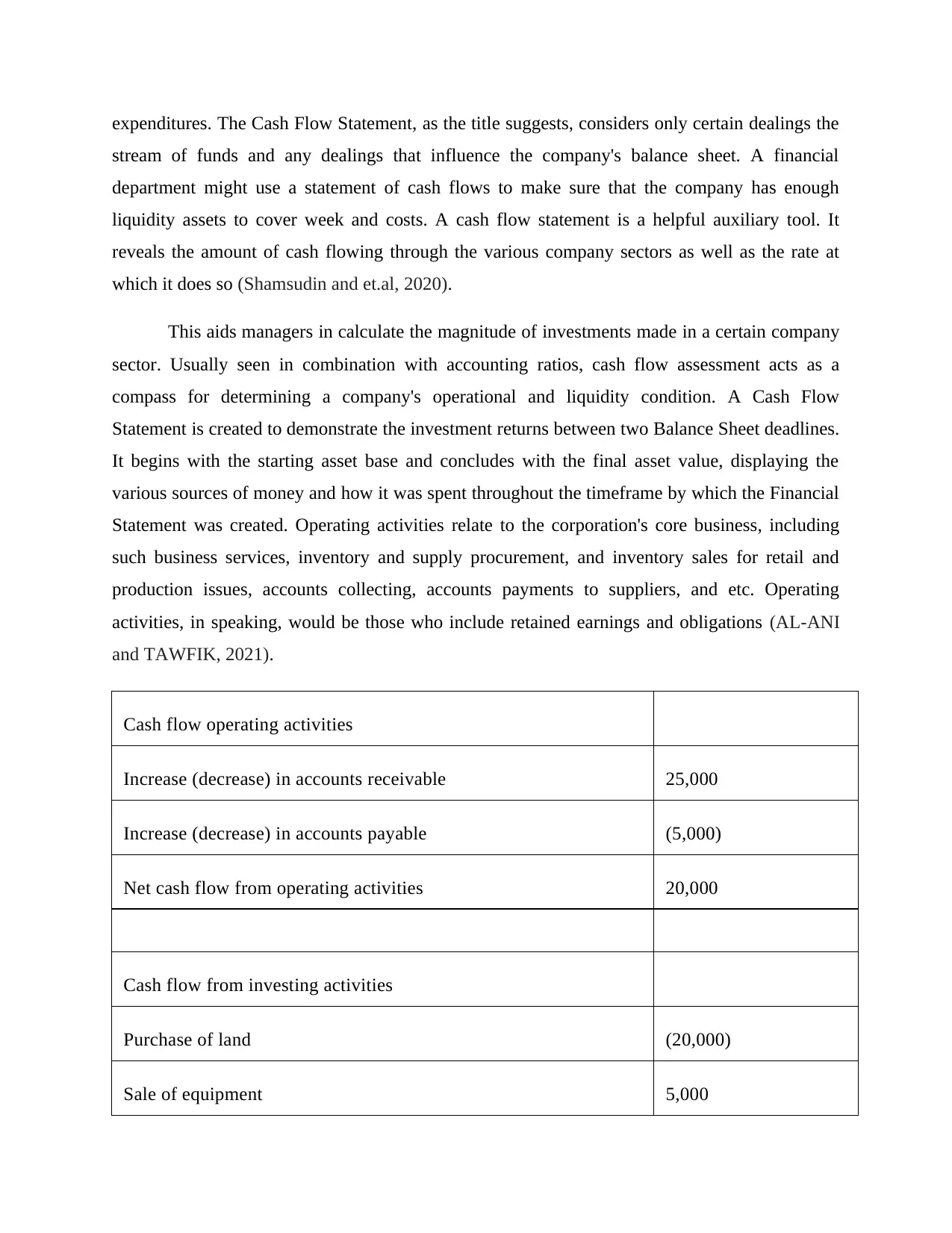
expenditures. The Cash Flow Statement, as the title suggests, considers only certain dealings the
stream of funds and any dealings that influence the company's balance sheet. A financial
department might use a statement of cash flows to make sure that the company has enough
liquidity assets to cover week and costs. A cash flow statement is a helpful auxiliary tool. It
reveals the amount of cash flowing through the various company sectors as well as the rate at
which it does so (Shamsudin and et.al, 2020).
This aids managers in calculate the magnitude of investments made in a certain company
sector. Usually seen in combination with accounting ratios, cash flow assessment acts as a
compass for determining a company's operational and liquidity condition. A Cash Flow
Statement is created to demonstrate the investment returns between two Balance Sheet deadlines.
It begins with the starting asset base and concludes with the final asset value, displaying the
various sources of money and how it was spent throughout the timeframe by which the Financial
Statement was created. Operating activities relate to the corporation's core business, including
such business services, inventory and supply procurement, and inventory sales for retail and
production issues, accounts collecting, accounts payments to suppliers, and etc. Operating
activities, in speaking, would be those who include retained earnings and obligations (AL-ANI
and TAWFIK, 2021).
Cash flow operating activities
Increase (decrease) in accounts receivable 25,000
Increase (decrease) in accounts payable (5,000)
Net cash flow from operating activities 20,000
Cash flow from investing activities
Purchase of land (20,000)
Sale of equipment 5,000
stream of funds and any dealings that influence the company's balance sheet. A financial
department might use a statement of cash flows to make sure that the company has enough
liquidity assets to cover week and costs. A cash flow statement is a helpful auxiliary tool. It
reveals the amount of cash flowing through the various company sectors as well as the rate at
which it does so (Shamsudin and et.al, 2020).
This aids managers in calculate the magnitude of investments made in a certain company
sector. Usually seen in combination with accounting ratios, cash flow assessment acts as a
compass for determining a company's operational and liquidity condition. A Cash Flow
Statement is created to demonstrate the investment returns between two Balance Sheet deadlines.
It begins with the starting asset base and concludes with the final asset value, displaying the
various sources of money and how it was spent throughout the timeframe by which the Financial
Statement was created. Operating activities relate to the corporation's core business, including
such business services, inventory and supply procurement, and inventory sales for retail and
production issues, accounts collecting, accounts payments to suppliers, and etc. Operating
activities, in speaking, would be those who include retained earnings and obligations (AL-ANI
and TAWFIK, 2021).
Cash flow operating activities
Increase (decrease) in accounts receivable 25,000
Increase (decrease) in accounts payable (5,000)
Net cash flow from operating activities 20,000
Cash flow from investing activities
Purchase of land (20,000)
Sale of equipment 5,000
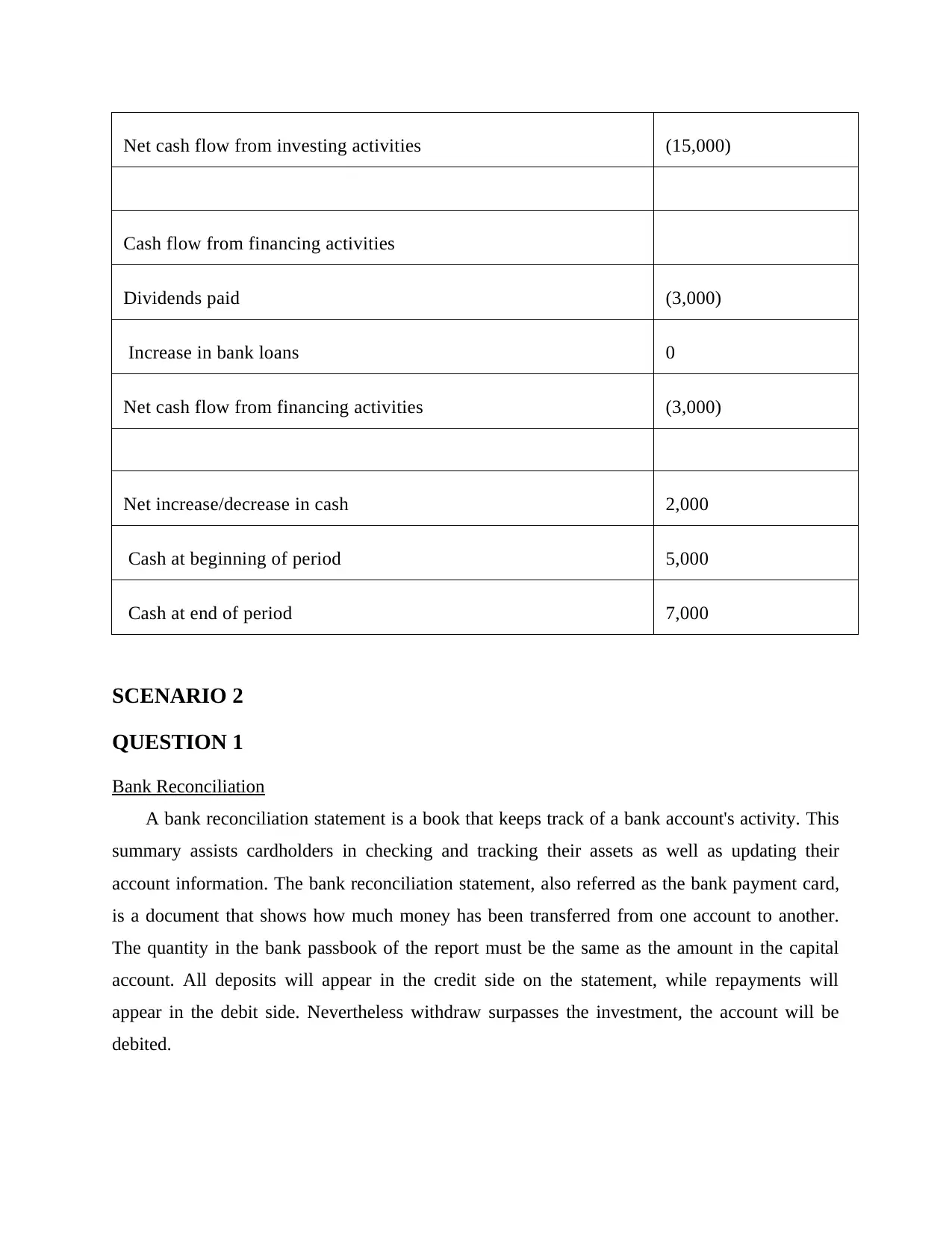
Net cash flow from investing activities (15,000)
Cash flow from financing activities
Dividends paid (3,000)
Increase in bank loans 0
Net cash flow from financing activities (3,000)
Net increase/decrease in cash 2,000
Cash at beginning of period 5,000
Cash at end of period 7,000
SCENARIO 2
QUESTION 1
Bank Reconciliation
A bank reconciliation statement is a book that keeps track of a bank account's activity. This
summary assists cardholders in checking and tracking their assets as well as updating their
account information. The bank reconciliation statement, also referred as the bank payment card,
is a document that shows how much money has been transferred from one account to another.
The quantity in the bank passbook of the report must be the same as the amount in the capital
account. All deposits will appear in the credit side on the statement, while repayments will
appear in the debit side. Nevertheless withdraw surpasses the investment, the account will be
debited.
Cash flow from financing activities
Dividends paid (3,000)
Increase in bank loans 0
Net cash flow from financing activities (3,000)
Net increase/decrease in cash 2,000
Cash at beginning of period 5,000
Cash at end of period 7,000
SCENARIO 2
QUESTION 1
Bank Reconciliation
A bank reconciliation statement is a book that keeps track of a bank account's activity. This
summary assists cardholders in checking and tracking their assets as well as updating their
account information. The bank reconciliation statement, also referred as the bank payment card,
is a document that shows how much money has been transferred from one account to another.
The quantity in the bank passbook of the report must be the same as the amount in the capital
account. All deposits will appear in the credit side on the statement, while repayments will
appear in the debit side. Nevertheless withdraw surpasses the investment, the account will be
debited.
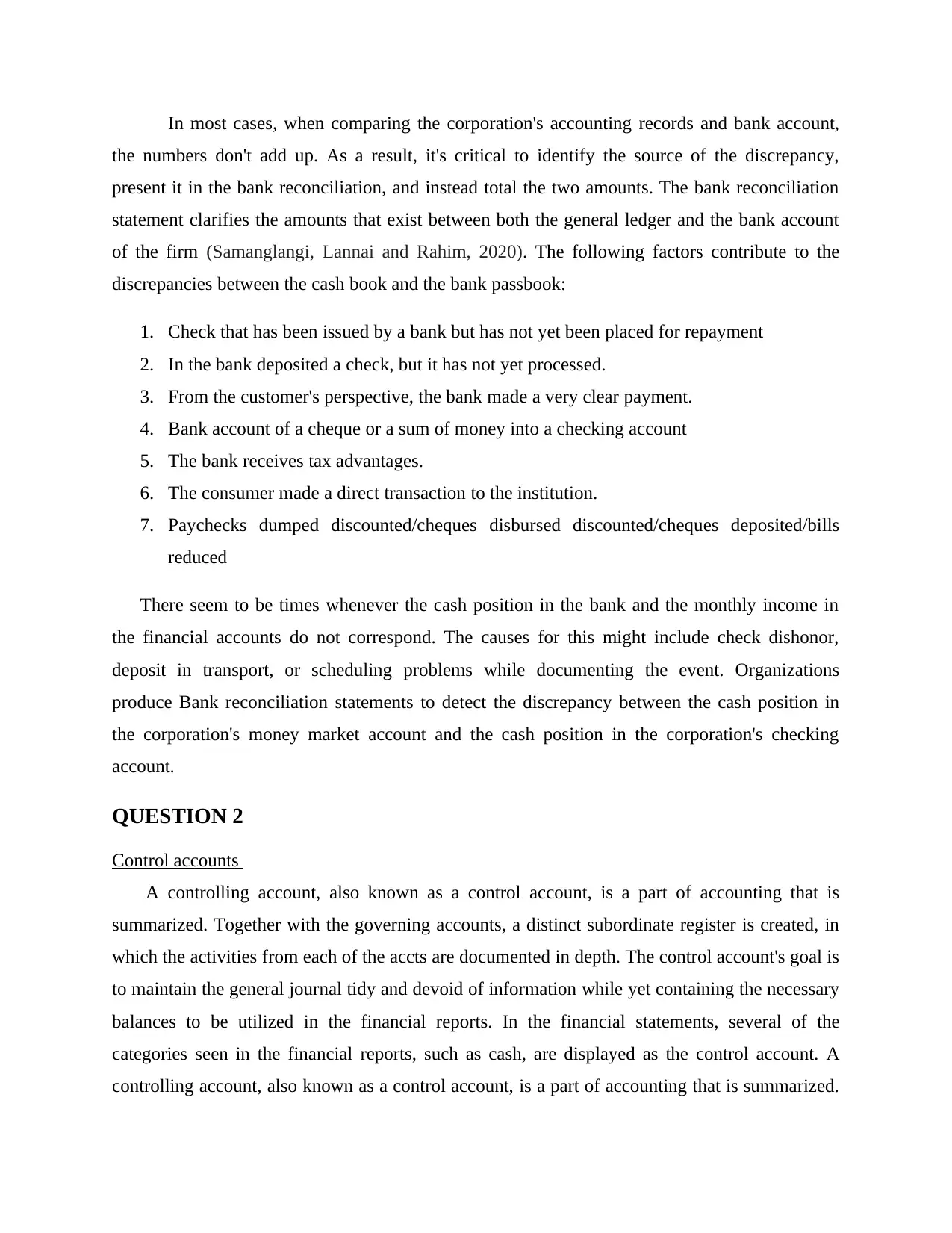
In most cases, when comparing the corporation's accounting records and bank account,
the numbers don't add up. As a result, it's critical to identify the source of the discrepancy,
present it in the bank reconciliation, and instead total the two amounts. The bank reconciliation
statement clarifies the amounts that exist between both the general ledger and the bank account
of the firm (Samanglangi, Lannai and Rahim, 2020). The following factors contribute to the
discrepancies between the cash book and the bank passbook:
1. Check that has been issued by a bank but has not yet been placed for repayment
2. In the bank deposited a check, but it has not yet processed.
3. From the customer's perspective, the bank made a very clear payment.
4. Bank account of a cheque or a sum of money into a checking account
5. The bank receives tax advantages.
6. The consumer made a direct transaction to the institution.
7. Paychecks dumped discounted/cheques disbursed discounted/cheques deposited/bills
reduced
There seem to be times whenever the cash position in the bank and the monthly income in
the financial accounts do not correspond. The causes for this might include check dishonor,
deposit in transport, or scheduling problems while documenting the event. Organizations
produce Bank reconciliation statements to detect the discrepancy between the cash position in
the corporation's money market account and the cash position in the corporation's checking
account.
QUESTION 2
Control accounts
A controlling account, also known as a control account, is a part of accounting that is
summarized. Together with the governing accounts, a distinct subordinate register is created, in
which the activities from each of the accts are documented in depth. The control account's goal is
to maintain the general journal tidy and devoid of information while yet containing the necessary
balances to be utilized in the financial reports. In the financial statements, several of the
categories seen in the financial reports, such as cash, are displayed as the control account. A
controlling account, also known as a control account, is a part of accounting that is summarized.
the numbers don't add up. As a result, it's critical to identify the source of the discrepancy,
present it in the bank reconciliation, and instead total the two amounts. The bank reconciliation
statement clarifies the amounts that exist between both the general ledger and the bank account
of the firm (Samanglangi, Lannai and Rahim, 2020). The following factors contribute to the
discrepancies between the cash book and the bank passbook:
1. Check that has been issued by a bank but has not yet been placed for repayment
2. In the bank deposited a check, but it has not yet processed.
3. From the customer's perspective, the bank made a very clear payment.
4. Bank account of a cheque or a sum of money into a checking account
5. The bank receives tax advantages.
6. The consumer made a direct transaction to the institution.
7. Paychecks dumped discounted/cheques disbursed discounted/cheques deposited/bills
reduced
There seem to be times whenever the cash position in the bank and the monthly income in
the financial accounts do not correspond. The causes for this might include check dishonor,
deposit in transport, or scheduling problems while documenting the event. Organizations
produce Bank reconciliation statements to detect the discrepancy between the cash position in
the corporation's money market account and the cash position in the corporation's checking
account.
QUESTION 2
Control accounts
A controlling account, also known as a control account, is a part of accounting that is
summarized. Together with the governing accounts, a distinct subordinate register is created, in
which the activities from each of the accts are documented in depth. The control account's goal is
to maintain the general journal tidy and devoid of information while yet containing the necessary
balances to be utilized in the financial reports. In the financial statements, several of the
categories seen in the financial reports, such as cash, are displayed as the control account. A
controlling account, also known as a control account, is a part of accounting that is summarized.
Paraphrase This Document
Need a fresh take? Get an instant paraphrase of this document with our AI Paraphraser
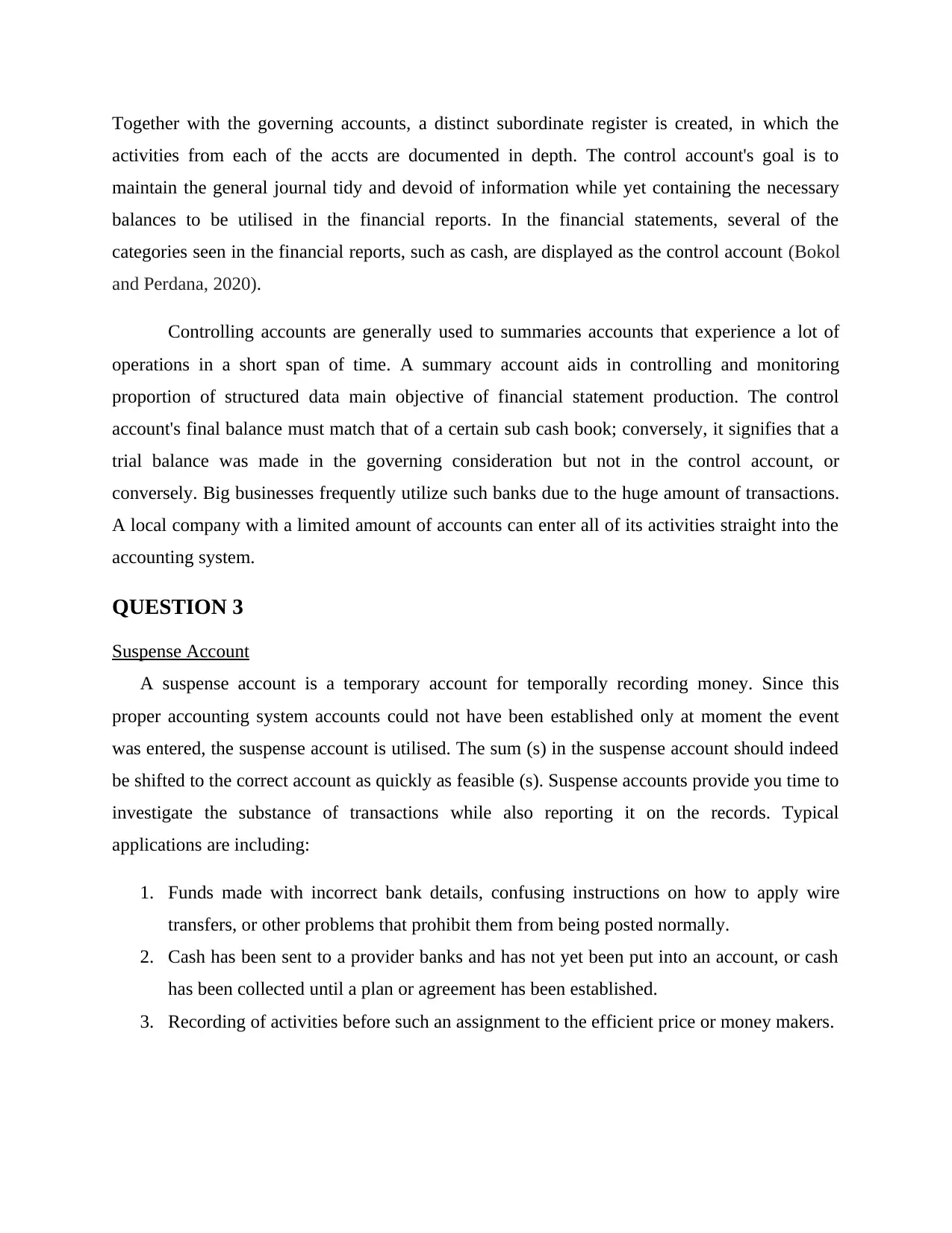
Together with the governing accounts, a distinct subordinate register is created, in which the
activities from each of the accts are documented in depth. The control account's goal is to
maintain the general journal tidy and devoid of information while yet containing the necessary
balances to be utilised in the financial reports. In the financial statements, several of the
categories seen in the financial reports, such as cash, are displayed as the control account (Bokol
and Perdana, 2020).
Controlling accounts are generally used to summaries accounts that experience a lot of
operations in a short span of time. A summary account aids in controlling and monitoring
proportion of structured data main objective of financial statement production. The control
account's final balance must match that of a certain sub cash book; conversely, it signifies that a
trial balance was made in the governing consideration but not in the control account, or
conversely. Big businesses frequently utilize such banks due to the huge amount of transactions.
A local company with a limited amount of accounts can enter all of its activities straight into the
accounting system.
QUESTION 3
Suspense Account
A suspense account is a temporary account for temporally recording money. Since this
proper accounting system accounts could not have been established only at moment the event
was entered, the suspense account is utilised. The sum (s) in the suspense account should indeed
be shifted to the correct account as quickly as feasible (s). Suspense accounts provide you time to
investigate the substance of transactions while also reporting it on the records. Typical
applications are including:
1. Funds made with incorrect bank details, confusing instructions on how to apply wire
transfers, or other problems that prohibit them from being posted normally.
2. Cash has been sent to a provider banks and has not yet been put into an account, or cash
has been collected until a plan or agreement has been established.
3. Recording of activities before such an assignment to the efficient price or money makers.
activities from each of the accts are documented in depth. The control account's goal is to
maintain the general journal tidy and devoid of information while yet containing the necessary
balances to be utilised in the financial reports. In the financial statements, several of the
categories seen in the financial reports, such as cash, are displayed as the control account (Bokol
and Perdana, 2020).
Controlling accounts are generally used to summaries accounts that experience a lot of
operations in a short span of time. A summary account aids in controlling and monitoring
proportion of structured data main objective of financial statement production. The control
account's final balance must match that of a certain sub cash book; conversely, it signifies that a
trial balance was made in the governing consideration but not in the control account, or
conversely. Big businesses frequently utilize such banks due to the huge amount of transactions.
A local company with a limited amount of accounts can enter all of its activities straight into the
accounting system.
QUESTION 3
Suspense Account
A suspense account is a temporary account for temporally recording money. Since this
proper accounting system accounts could not have been established only at moment the event
was entered, the suspense account is utilised. The sum (s) in the suspense account should indeed
be shifted to the correct account as quickly as feasible (s). Suspense accounts provide you time to
investigate the substance of transactions while also reporting it on the records. Typical
applications are including:
1. Funds made with incorrect bank details, confusing instructions on how to apply wire
transfers, or other problems that prohibit them from being posted normally.
2. Cash has been sent to a provider banks and has not yet been put into an account, or cash
has been collected until a plan or agreement has been established.
3. Recording of activities before such an assignment to the efficient price or money makers.
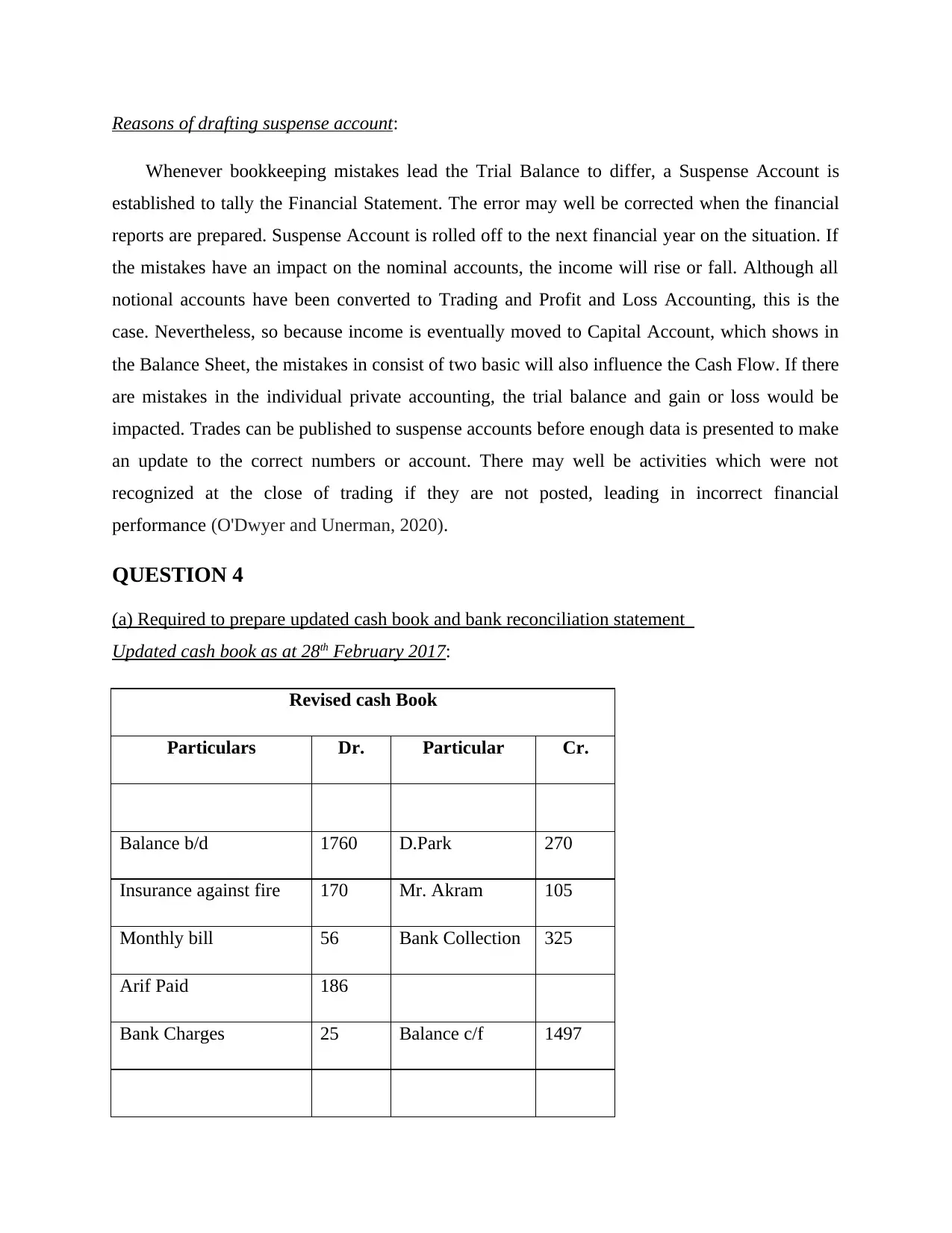
Reasons of drafting suspense account:
Whenever bookkeeping mistakes lead the Trial Balance to differ, a Suspense Account is
established to tally the Financial Statement. The error may well be corrected when the financial
reports are prepared. Suspense Account is rolled off to the next financial year on the situation. If
the mistakes have an impact on the nominal accounts, the income will rise or fall. Although all
notional accounts have been converted to Trading and Profit and Loss Accounting, this is the
case. Nevertheless, so because income is eventually moved to Capital Account, which shows in
the Balance Sheet, the mistakes in consist of two basic will also influence the Cash Flow. If there
are mistakes in the individual private accounting, the trial balance and gain or loss would be
impacted. Trades can be published to suspense accounts before enough data is presented to make
an update to the correct numbers or account. There may well be activities which were not
recognized at the close of trading if they are not posted, leading in incorrect financial
performance (O'Dwyer and Unerman, 2020).
QUESTION 4
(a) Required to prepare updated cash book and bank reconciliation statement
Updated cash book as at 28th February 2017:
Revised cash Book
Particulars Dr. Particular Cr.
Balance b/d 1760 D.Park 270
Insurance against fire 170 Mr. Akram 105
Monthly bill 56 Bank Collection 325
Arif Paid 186
Bank Charges 25 Balance c/f 1497
Whenever bookkeeping mistakes lead the Trial Balance to differ, a Suspense Account is
established to tally the Financial Statement. The error may well be corrected when the financial
reports are prepared. Suspense Account is rolled off to the next financial year on the situation. If
the mistakes have an impact on the nominal accounts, the income will rise or fall. Although all
notional accounts have been converted to Trading and Profit and Loss Accounting, this is the
case. Nevertheless, so because income is eventually moved to Capital Account, which shows in
the Balance Sheet, the mistakes in consist of two basic will also influence the Cash Flow. If there
are mistakes in the individual private accounting, the trial balance and gain or loss would be
impacted. Trades can be published to suspense accounts before enough data is presented to make
an update to the correct numbers or account. There may well be activities which were not
recognized at the close of trading if they are not posted, leading in incorrect financial
performance (O'Dwyer and Unerman, 2020).
QUESTION 4
(a) Required to prepare updated cash book and bank reconciliation statement
Updated cash book as at 28th February 2017:
Revised cash Book
Particulars Dr. Particular Cr.
Balance b/d 1760 D.Park 270
Insurance against fire 170 Mr. Akram 105
Monthly bill 56 Bank Collection 325
Arif Paid 186
Bank Charges 25 Balance c/f 1497
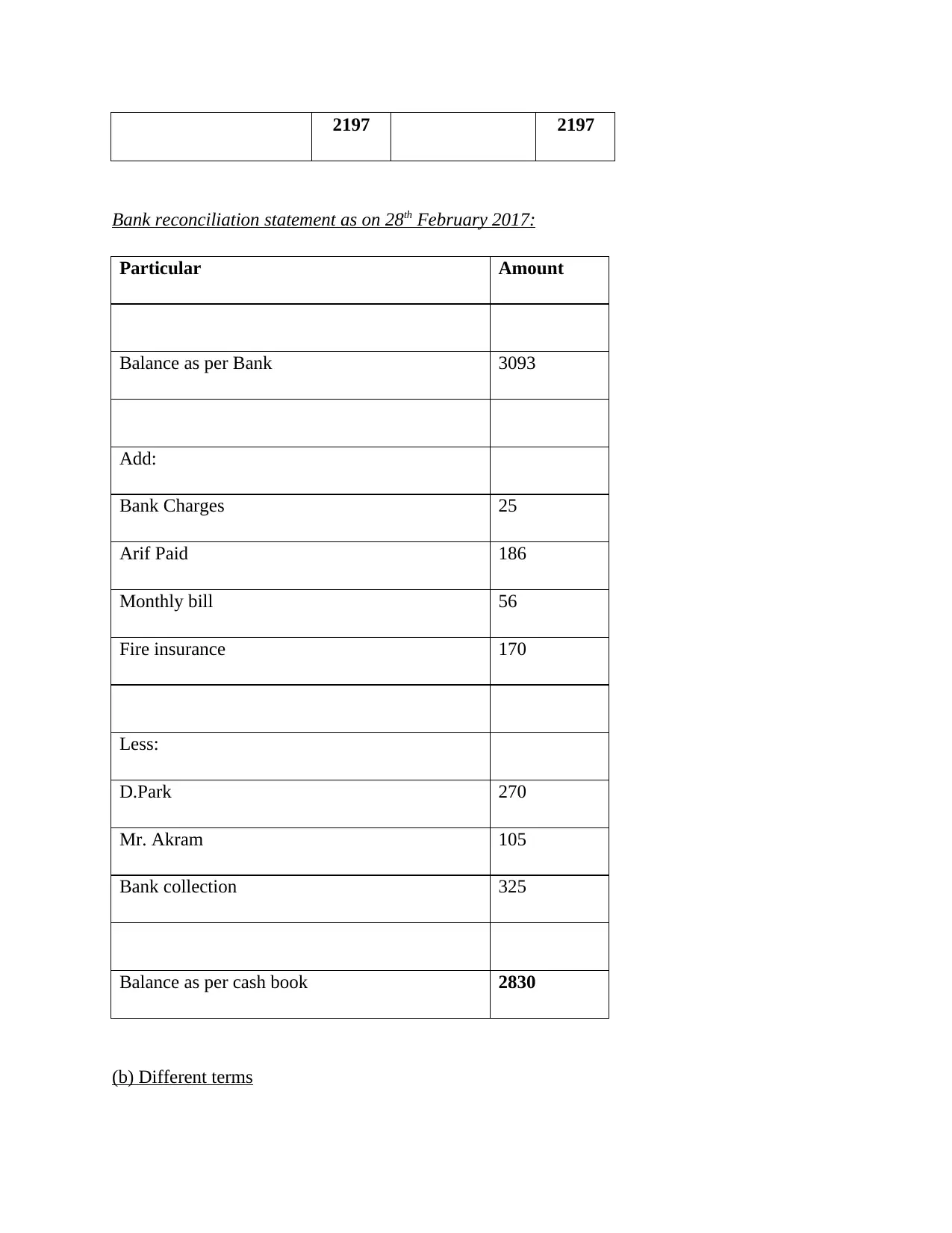
2197 2197
Bank reconciliation statement as on 28th February 2017:
Particular Amount
Balance as per Bank 3093
Add:
Bank Charges 25
Arif Paid 186
Monthly bill 56
Fire insurance 170
Less:
D.Park 270
Mr. Akram 105
Bank collection 325
Balance as per cash book 2830
(b) Different terms
Bank reconciliation statement as on 28th February 2017:
Particular Amount
Balance as per Bank 3093
Add:
Bank Charges 25
Arif Paid 186
Monthly bill 56
Fire insurance 170
Less:
D.Park 270
Mr. Akram 105
Bank collection 325
Balance as per cash book 2830
(b) Different terms
Secure Best Marks with AI Grader
Need help grading? Try our AI Grader for instant feedback on your assignments.
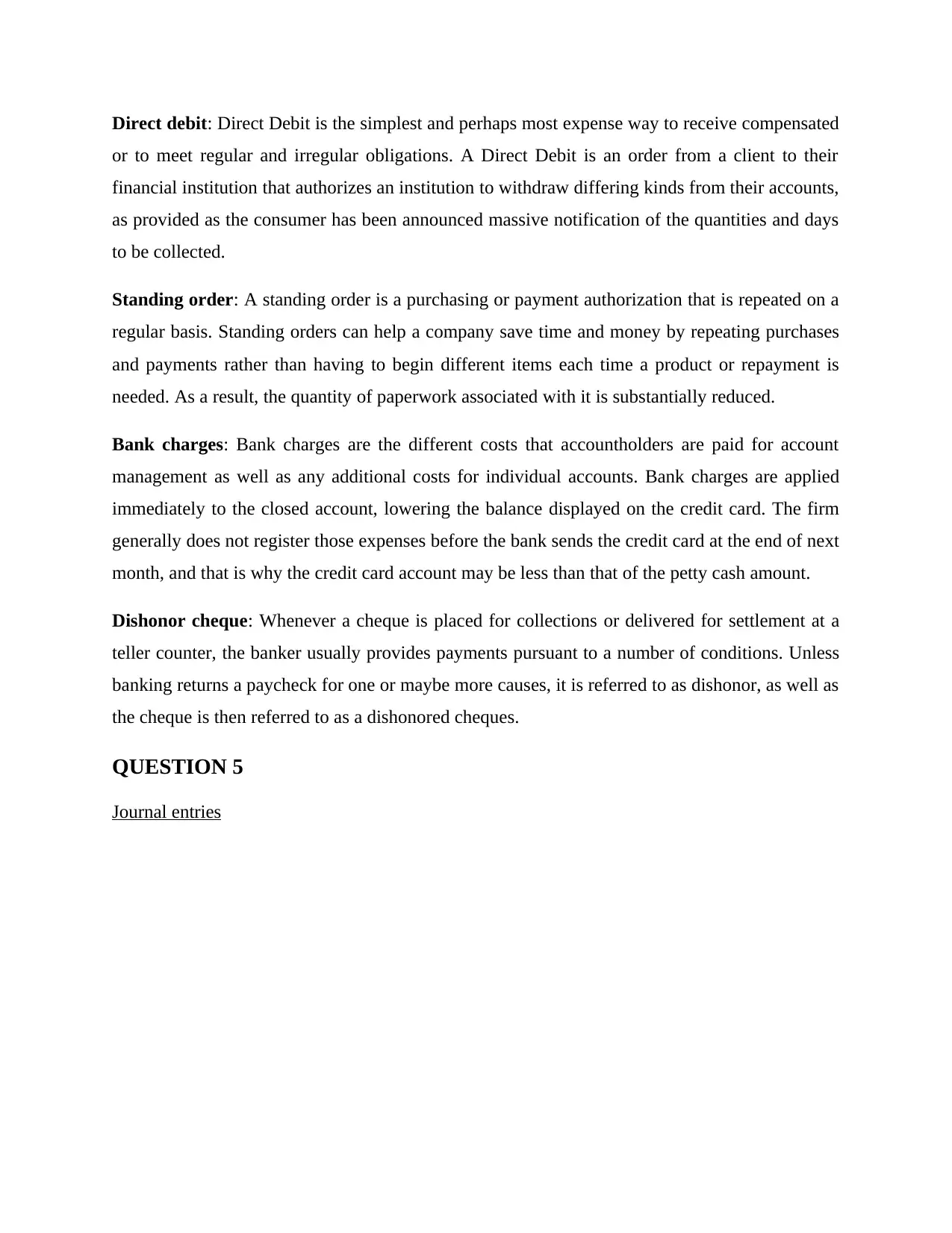
Direct debit: Direct Debit is the simplest and perhaps most expense way to receive compensated
or to meet regular and irregular obligations. A Direct Debit is an order from a client to their
financial institution that authorizes an institution to withdraw differing kinds from their accounts,
as provided as the consumer has been announced massive notification of the quantities and days
to be collected.
Standing order: A standing order is a purchasing or payment authorization that is repeated on a
regular basis. Standing orders can help a company save time and money by repeating purchases
and payments rather than having to begin different items each time a product or repayment is
needed. As a result, the quantity of paperwork associated with it is substantially reduced.
Bank charges: Bank charges are the different costs that accountholders are paid for account
management as well as any additional costs for individual accounts. Bank charges are applied
immediately to the closed account, lowering the balance displayed on the credit card. The firm
generally does not register those expenses before the bank sends the credit card at the end of next
month, and that is why the credit card account may be less than that of the petty cash amount.
Dishonor cheque: Whenever a cheque is placed for collections or delivered for settlement at a
teller counter, the banker usually provides payments pursuant to a number of conditions. Unless
banking returns a paycheck for one or maybe more causes, it is referred to as dishonor, as well as
the cheque is then referred to as a dishonored cheques.
QUESTION 5
Journal entries
or to meet regular and irregular obligations. A Direct Debit is an order from a client to their
financial institution that authorizes an institution to withdraw differing kinds from their accounts,
as provided as the consumer has been announced massive notification of the quantities and days
to be collected.
Standing order: A standing order is a purchasing or payment authorization that is repeated on a
regular basis. Standing orders can help a company save time and money by repeating purchases
and payments rather than having to begin different items each time a product or repayment is
needed. As a result, the quantity of paperwork associated with it is substantially reduced.
Bank charges: Bank charges are the different costs that accountholders are paid for account
management as well as any additional costs for individual accounts. Bank charges are applied
immediately to the closed account, lowering the balance displayed on the credit card. The firm
generally does not register those expenses before the bank sends the credit card at the end of next
month, and that is why the credit card account may be less than that of the petty cash amount.
Dishonor cheque: Whenever a cheque is placed for collections or delivered for settlement at a
teller counter, the banker usually provides payments pursuant to a number of conditions. Unless
banking returns a paycheck for one or maybe more causes, it is referred to as dishonor, as well as
the cheque is then referred to as a dishonored cheques.
QUESTION 5
Journal entries
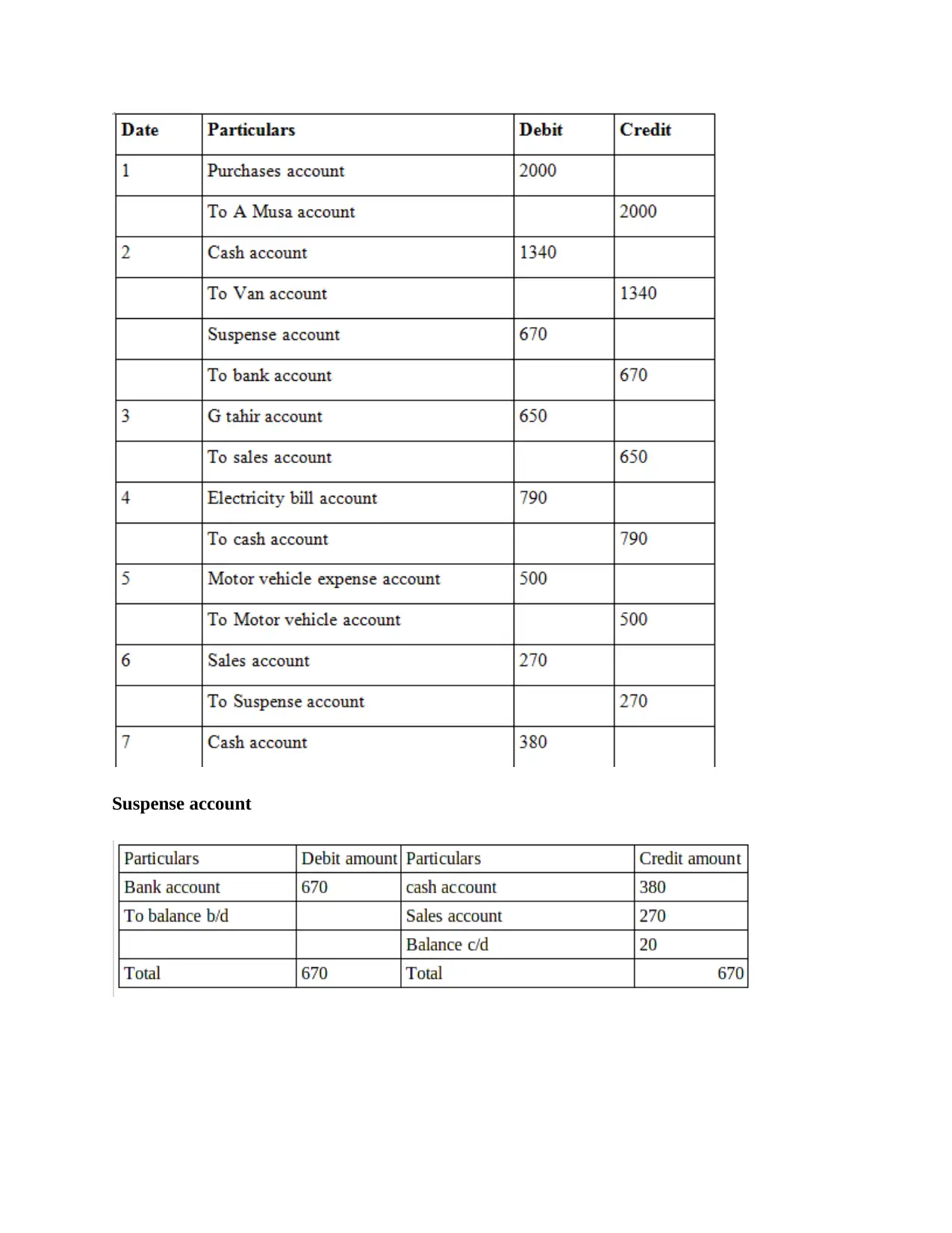
Suspense account
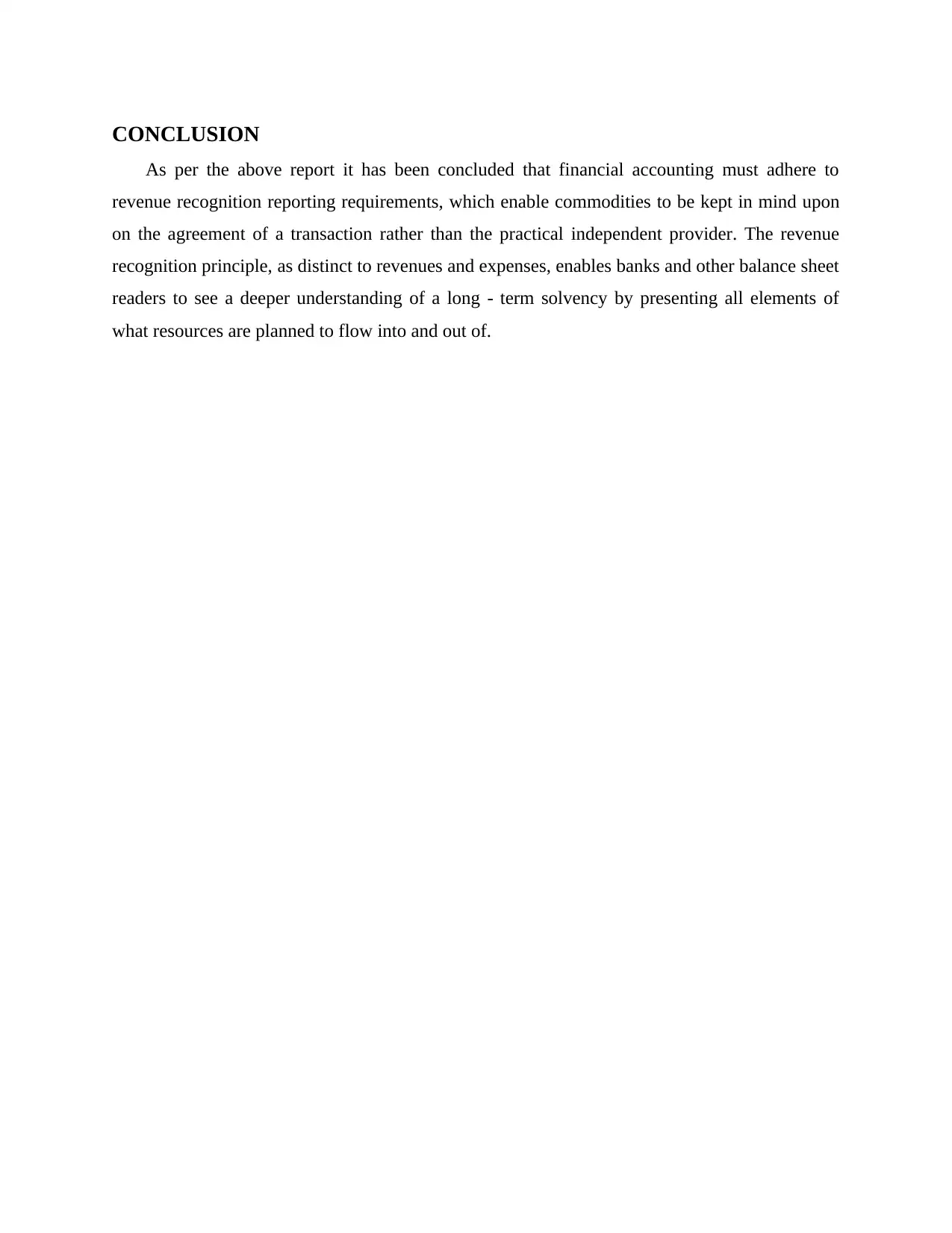
CONCLUSION
As per the above report it has been concluded that financial accounting must adhere to
revenue recognition reporting requirements, which enable commodities to be kept in mind upon
on the agreement of a transaction rather than the practical independent provider. The revenue
recognition principle, as distinct to revenues and expenses, enables banks and other balance sheet
readers to see a deeper understanding of a long - term solvency by presenting all elements of
what resources are planned to flow into and out of.
As per the above report it has been concluded that financial accounting must adhere to
revenue recognition reporting requirements, which enable commodities to be kept in mind upon
on the agreement of a transaction rather than the practical independent provider. The revenue
recognition principle, as distinct to revenues and expenses, enables banks and other balance sheet
readers to see a deeper understanding of a long - term solvency by presenting all elements of
what resources are planned to flow into and out of.
Paraphrase This Document
Need a fresh take? Get an instant paraphrase of this document with our AI Paraphraser
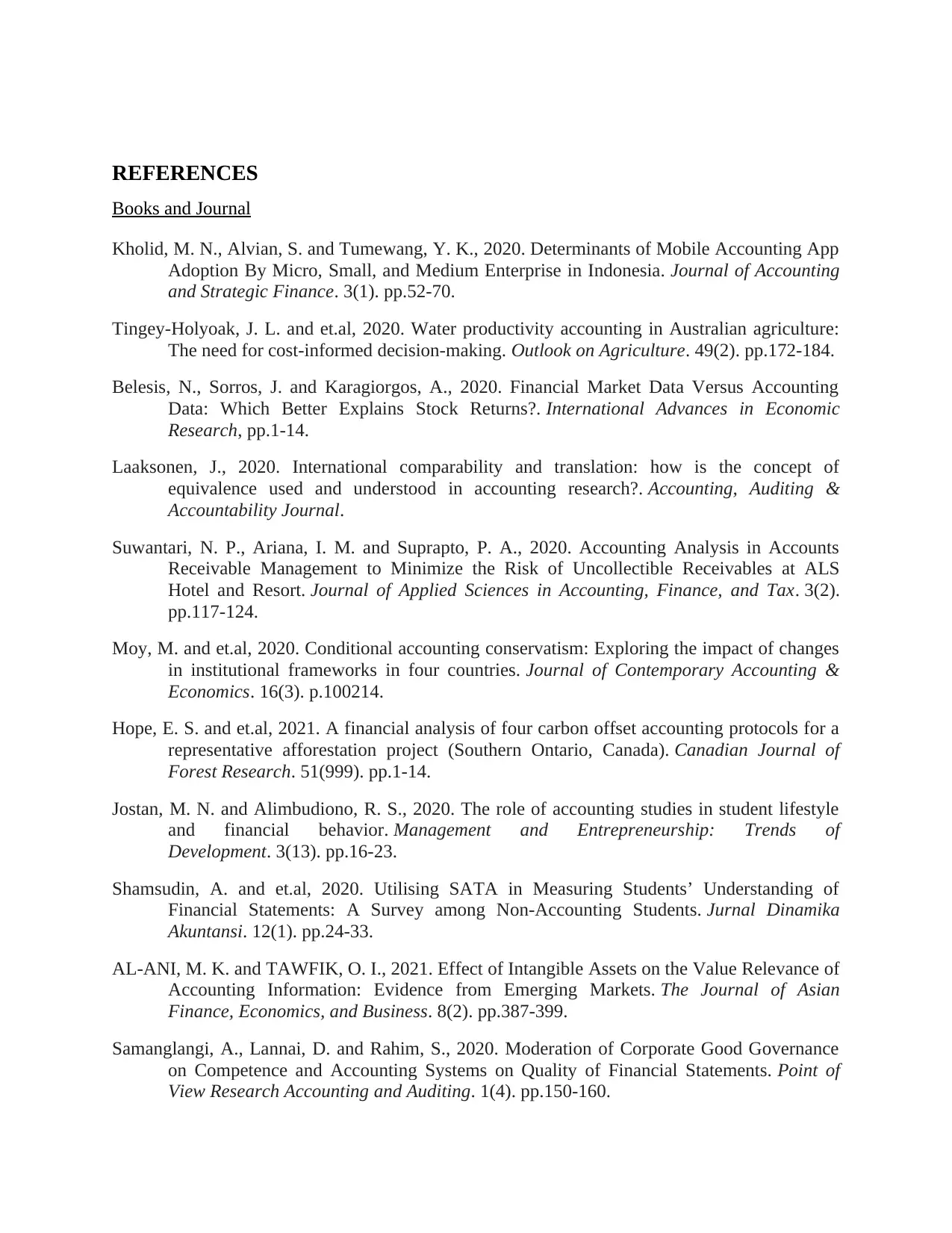
REFERENCES
Books and Journal
Kholid, M. N., Alvian, S. and Tumewang, Y. K., 2020. Determinants of Mobile Accounting App
Adoption By Micro, Small, and Medium Enterprise in Indonesia. Journal of Accounting
and Strategic Finance. 3(1). pp.52-70.
Tingey-Holyoak, J. L. and et.al, 2020. Water productivity accounting in Australian agriculture:
The need for cost-informed decision-making. Outlook on Agriculture. 49(2). pp.172-184.
Belesis, N., Sorros, J. and Karagiorgos, A., 2020. Financial Market Data Versus Accounting
Data: Which Better Explains Stock Returns?. International Advances in Economic
Research, pp.1-14.
Laaksonen, J., 2020. International comparability and translation: how is the concept of
equivalence used and understood in accounting research?. Accounting, Auditing &
Accountability Journal.
Suwantari, N. P., Ariana, I. M. and Suprapto, P. A., 2020. Accounting Analysis in Accounts
Receivable Management to Minimize the Risk of Uncollectible Receivables at ALS
Hotel and Resort. Journal of Applied Sciences in Accounting, Finance, and Tax. 3(2).
pp.117-124.
Moy, M. and et.al, 2020. Conditional accounting conservatism: Exploring the impact of changes
in institutional frameworks in four countries. Journal of Contemporary Accounting &
Economics. 16(3). p.100214.
Hope, E. S. and et.al, 2021. A financial analysis of four carbon offset accounting protocols for a
representative afforestation project (Southern Ontario, Canada). Canadian Journal of
Forest Research. 51(999). pp.1-14.
Jostan, M. N. and Alimbudiono, R. S., 2020. The role of accounting studies in student lifestyle
and financial behavior. Management and Entrepreneurship: Trends of
Development. 3(13). pp.16-23.
Shamsudin, A. and et.al, 2020. Utilising SATA in Measuring Students’ Understanding of
Financial Statements: A Survey among Non-Accounting Students. Jurnal Dinamika
Akuntansi. 12(1). pp.24-33.
AL-ANI, M. K. and TAWFIK, O. I., 2021. Effect of Intangible Assets on the Value Relevance of
Accounting Information: Evidence from Emerging Markets. The Journal of Asian
Finance, Economics, and Business. 8(2). pp.387-399.
Samanglangi, A., Lannai, D. and Rahim, S., 2020. Moderation of Corporate Good Governance
on Competence and Accounting Systems on Quality of Financial Statements. Point of
View Research Accounting and Auditing. 1(4). pp.150-160.
Books and Journal
Kholid, M. N., Alvian, S. and Tumewang, Y. K., 2020. Determinants of Mobile Accounting App
Adoption By Micro, Small, and Medium Enterprise in Indonesia. Journal of Accounting
and Strategic Finance. 3(1). pp.52-70.
Tingey-Holyoak, J. L. and et.al, 2020. Water productivity accounting in Australian agriculture:
The need for cost-informed decision-making. Outlook on Agriculture. 49(2). pp.172-184.
Belesis, N., Sorros, J. and Karagiorgos, A., 2020. Financial Market Data Versus Accounting
Data: Which Better Explains Stock Returns?. International Advances in Economic
Research, pp.1-14.
Laaksonen, J., 2020. International comparability and translation: how is the concept of
equivalence used and understood in accounting research?. Accounting, Auditing &
Accountability Journal.
Suwantari, N. P., Ariana, I. M. and Suprapto, P. A., 2020. Accounting Analysis in Accounts
Receivable Management to Minimize the Risk of Uncollectible Receivables at ALS
Hotel and Resort. Journal of Applied Sciences in Accounting, Finance, and Tax. 3(2).
pp.117-124.
Moy, M. and et.al, 2020. Conditional accounting conservatism: Exploring the impact of changes
in institutional frameworks in four countries. Journal of Contemporary Accounting &
Economics. 16(3). p.100214.
Hope, E. S. and et.al, 2021. A financial analysis of four carbon offset accounting protocols for a
representative afforestation project (Southern Ontario, Canada). Canadian Journal of
Forest Research. 51(999). pp.1-14.
Jostan, M. N. and Alimbudiono, R. S., 2020. The role of accounting studies in student lifestyle
and financial behavior. Management and Entrepreneurship: Trends of
Development. 3(13). pp.16-23.
Shamsudin, A. and et.al, 2020. Utilising SATA in Measuring Students’ Understanding of
Financial Statements: A Survey among Non-Accounting Students. Jurnal Dinamika
Akuntansi. 12(1). pp.24-33.
AL-ANI, M. K. and TAWFIK, O. I., 2021. Effect of Intangible Assets on the Value Relevance of
Accounting Information: Evidence from Emerging Markets. The Journal of Asian
Finance, Economics, and Business. 8(2). pp.387-399.
Samanglangi, A., Lannai, D. and Rahim, S., 2020. Moderation of Corporate Good Governance
on Competence and Accounting Systems on Quality of Financial Statements. Point of
View Research Accounting and Auditing. 1(4). pp.150-160.
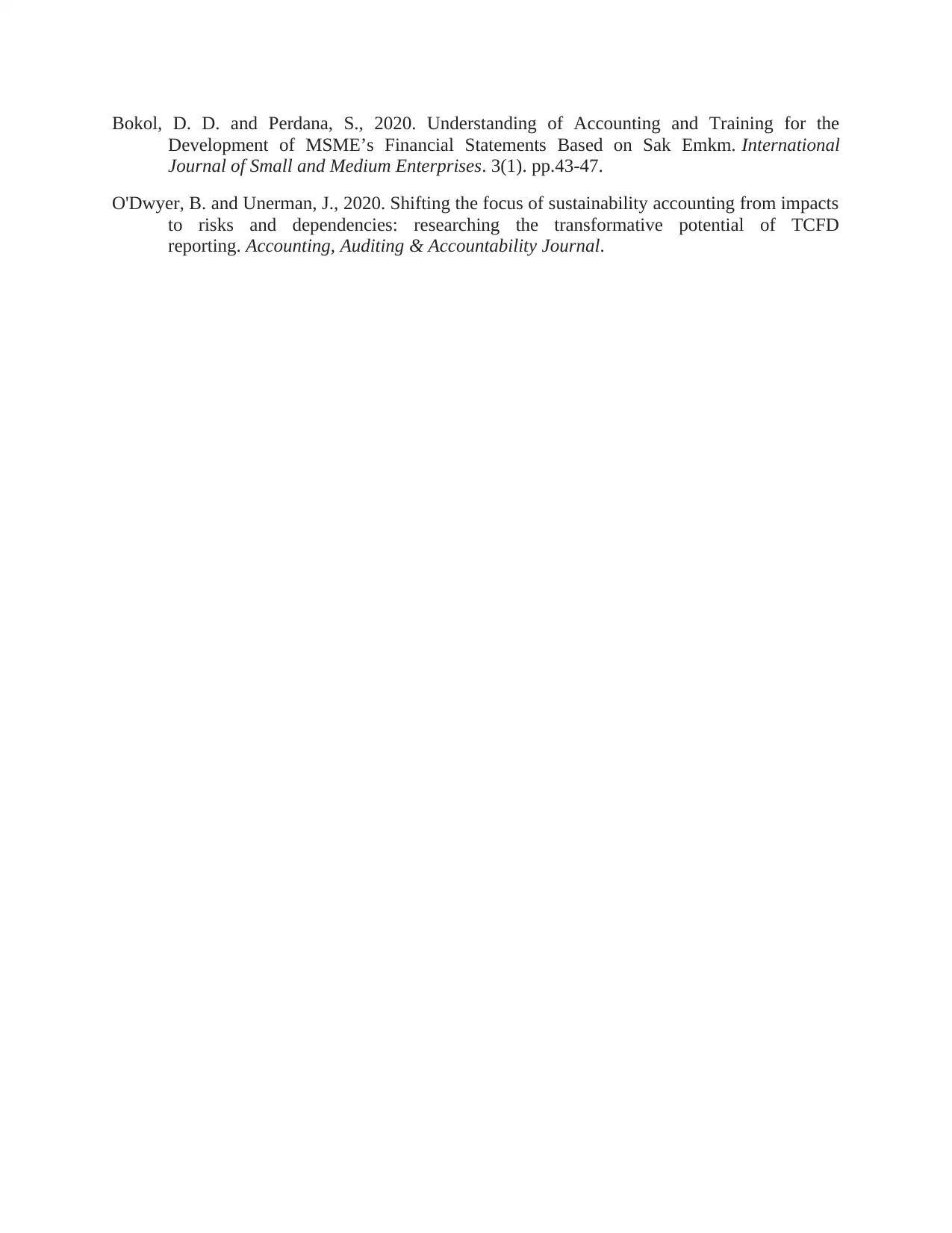
Bokol, D. D. and Perdana, S., 2020. Understanding of Accounting and Training for the
Development of MSME’s Financial Statements Based on Sak Emkm. International
Journal of Small and Medium Enterprises. 3(1). pp.43-47.
O'Dwyer, B. and Unerman, J., 2020. Shifting the focus of sustainability accounting from impacts
to risks and dependencies: researching the transformative potential of TCFD
reporting. Accounting, Auditing & Accountability Journal.
Development of MSME’s Financial Statements Based on Sak Emkm. International
Journal of Small and Medium Enterprises. 3(1). pp.43-47.
O'Dwyer, B. and Unerman, J., 2020. Shifting the focus of sustainability accounting from impacts
to risks and dependencies: researching the transformative potential of TCFD
reporting. Accounting, Auditing & Accountability Journal.
1 out of 27
Related Documents
Your All-in-One AI-Powered Toolkit for Academic Success.
+13062052269
info@desklib.com
Available 24*7 on WhatsApp / Email
![[object Object]](/_next/static/media/star-bottom.7253800d.svg)
Unlock your academic potential
© 2024 | Zucol Services PVT LTD | All rights reserved.





